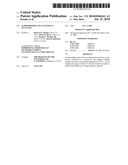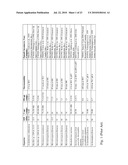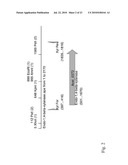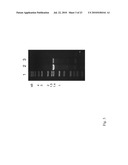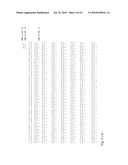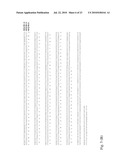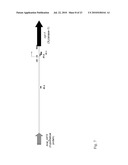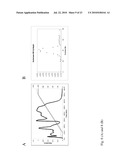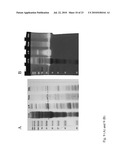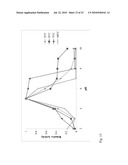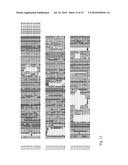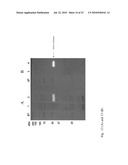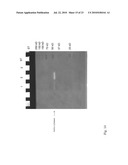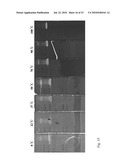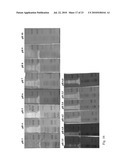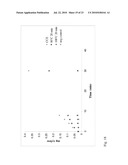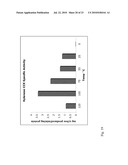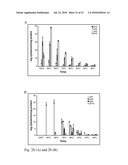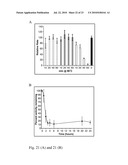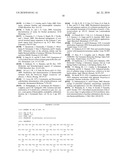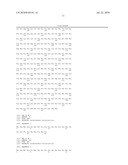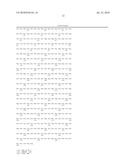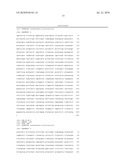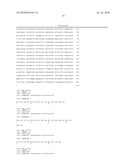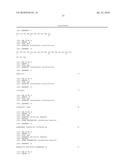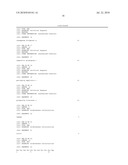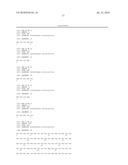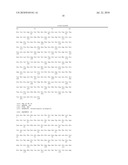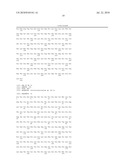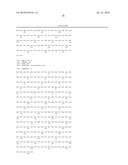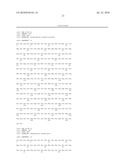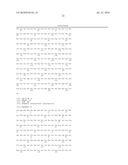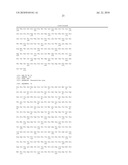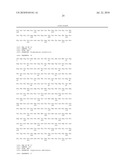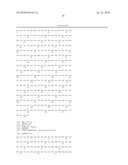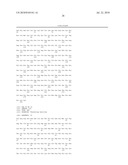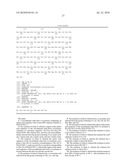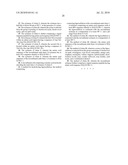Patent application title: ACIDOTHERMUS CELLULOYTICUS XYLANASE
Inventors:
Rebecca E. Parales (Davis, CA, US)
Alison M. Berry (Davis, CA, US)
Juanito V. Parales, Jr. (Davis, CA, US)
Ravi D. Barabote (Davis, CA, US)
Assignees:
THE REGENTS OF THE UNIVERSITY OF CALIFORNIA
IPC8 Class: AC12P1904FI
USPC Class:
435101
Class name: Micro-organism, tissue cell culture or enzyme using process to synthesize a desired chemical compound or composition preparing compound containing saccharide radical polysaccharide of more than five saccharide radicals attached to each other by glycosidic bonds
Publication date: 2010-07-22
Patent application number: 20100184161
Claims:
1. A recombinant endo-beta-1,4-xylanase comprising an amino acid sequence
with at least 80% sequence identity to SEQ ID NO: 1.
2. The xylanase of claim 1, wherein a region of the amino acid sequence of the recombinant endo-beta-1,4-xylanase conforms to consensus sequence: Pro-Xaa1-Pro-Xaa2-Pro (SEQ ID NO: 40), wherein Xaa1 and Xaa2 are each independently selected from the group consisting of: no amino acid, any 1 amino acid, any 2 amino acids, and any 3 amino acids.
3. The xylanase of claim 2, wherein the amino acid sequence of the recombinant endo-beta-1,4-xylanase comprises a first Glu at a position corresponding to Glu-142 of SEQ ID NO: 1, and a second Glu at a position corresponding to Glu-259 of SEQ ID NO: 1, wherein the region of the amino acid sequence of the recombinant endo-beta-1,4-xylanase is located between the first Glu and the second Glu.
4. The xylanase of claim 2, wherein Xaa1 is one amino acid selected from the group consisting of: His, Lys, and Arg.
5. The xylanase of claim 2, wherein Xaa2 is one amino acid selected from the group consisting of: Leu, Ala, Val, Ile, Pro, Phe, Met, and Trp.
6. The xylanase of claim 2, wherein the region of the amino acid sequence of the recombinant endo-beta-1,4-xylanase is Pro-His-Pro-Leu-Pro (SEQ ID NO: 27).
7. The xylanase of claim 1, wherein the xylanase is active at pH values of about 3 to 9.
8. The xylanase of claim 1, wherein the xylanase has a pH optimum of about 4.5 to 6.0.
9. The xylanase of claim 1, wherein the xylanase has a molecular weight of about 40-48 kD.
10. The xylanase of claim 1, wherein the xylanase is active at least from about 80-120.degree. C.
11. The xylanase of claim 1, wherein the xylanase has optimal activity at about 90.degree. C.
12. The xylanase of claim 1, wherein the xylanase retains at least 50% of initial activity, at 90.degree. C., after incubation for at least 20 min at 90.degree. C.
13. The xylanase of claim 1, wherein the xylanase has a half-life of about 90 min at 90.degree. C. in the presence of a xylan.
14. The xylanase of claim 13, wherein the xylan is selected from the group consisting of: birchwood xylan, beech wood xylan, and oat spelt xylan.
15. The xylanase of claim 1, further comprising a signal sequence peptide having amino acid sequence SEQ ID NO: 2.
16. The xylanase of claim 3, wherein the first Glu is located within an amino acid region having a sequence of Asp-Val-Ala-Asn-Glu (SEQ ID NO: 25).
17. The xylanase of claim 3, wherein the second Glu is located within an amino acid region having a sequence of Thr-Glu-Ala-Asp (SEQ ID NO: 26).
18. The xylanase of claim 1, wherein the amino acid sequence of the recombinant endo-beta-1,4-xylanase has at least 95% sequence identity to SEQ ID NO: 1.
19. The xylanase of claim 1, wherein the amino acid sequence of the recombinant endo-beta-1,4-xylanase is SEQ ID NO: 1.
20. A recombinant cell comprising a nucleic acid molecule encoding the endo-beta-1,4-xylanase of claim 1.
21. A method for hydrolyzing lignocellulose, the method comprising:contacting lignocellulose with a recombinant endo-beta-1,4-xylanase comprising an amino acid sequence with at least 80% sequence identity to SEQ ID NO: 1, wherein the lignocellulose is contacted with the recombinant xylanase at a temperature of at least 80.degree. C. and a pH range from about 4.5-6.0.
22. The method of claim 21, wherein the lignocellulose is contacted with the recombinant xylanase at a temperature of at least 90.degree. C.
23. The method of claim 21, wherein t the amino acid sequence of the recombinant endo-beta-1,4-xylanase is SEQ ID NO: 1.
24. The method of claim 21, wherein a source of the lignocellulose is selected from the group consisting of: birchwood, oat spelt, switchgrass, corn stover, miscanthus, energy cane, sorghum, eucalyptus, willow, bagasse, hybrid poplar, short-rotation woody crop, conifer softwood, crop residue, yard waste, and a combination thereof.
25. The method of claim 21, wherein the recombinant xylanase further comprises a signal sequence peptide having amino acid sequence SEQ ID NO: 2.
Description:
[0001]This application claims the benefit under 35 USC 119(e) of U.S.
Provisional Patent Application No. 61/203,528, filed Dec. 22, 2008, the
disclosure of which is hereby incorporated by reference in its entirety.
BACKGROUND
[0002]1. Field
[0003]The present disclosure relates to xylanases and methods for their expression and use. Specifically, the disclosure is related to a thermophilic xylanase (Xyl-1) and homologs thereof derived from Acidothermus cellulolyticus, and the use of these enzymes in hydrolyzing lignocellulose.
[0004]2. Related Art
[0005]Lignocellulose is plant biomass composed of cellulose, hemicellulose, and lignin. Lignocellulose serves as an abundant and inexpensive source of fermentable biomass. However, one barrier to the utilization of lignocellulose is the tight crosslinking of the cellulose and hemicellulose to the lignin. Breaking down lignocellulose (i.e. separating cellulose and hemicellulose from lignin) is energy intensive, and thus inefficient. Efficient utilization of lignocellulosic biomass will enhance the economic competitiveness of bioconversion processes which must compete with petrochemical processes. It has been shown that xylanase enzymes can be used to efficiently break down lignocellulose.
[0006]Xylanase enzymes are important in a wide variety of biotechnological and industrial applications. These include prebleaching of kraft pulp in the pulp and paper industry, recovery of cellulose fiber in textiles, enhancing digestibility of animal feed and silage, clarification of juices and beer, separation of cereal gluten and starch, assorted applications in the bakery industry, as well as the production of xylo-oligosaccharides for pharmacological applications and food additives (1, 2, 9, 14, and 21). Furthermore, recent interest in biofuels production from lignocellulosic plant biomass has brought xylanases into renewed prominence (5). Collins et al. (4) recently reviewed the physicochemical and functional characteristics of xylanases from six different families, their mechanism of action, and industrial applications.
[0007]Xylanase production is commonly obtained from Trichoderma reesei and Trichoderma harzianum strain E58, both from the Forintek Canada Corp. culture collection. Although both fungi are prolific producers of extracellular xylanases, fungal growth and enzyme production can only be carried out at mesophilic temperatures (e.g., 28° C.). Consequently the fermentation requires considerable cooling water during fungal growth and is easily subjected to bacterial contamination. The xylanase enzymes produced are also thermally unstable, losing over 90% of their activities within a half hour of incubation at 50° C. As a result, enzymatic hydrolysis of lignocellulose using these enzymes has to be carried out at a lower temperature of about 37-45° C. This in turn lowers the hydrolysis efficiencies, necessitates asceptic conditions during hydrolysis, as well as preventing prolonged enzyme use without replacement. However, higher efficiency of hydrolysis can be obtained by using thermophilic xylanases.
[0008]Recently, several thermophilic xylanases from fungal and bacterial microorganisms have been identified (FIG. 1). For example, U.S. Pat. No. 5,935,836 discloses a thermophilic xylanase isolated from Actinomadura flexuosa that has an optimal pH of 6.0-7.0 and a temperature range of 70-80° C. In addition, U.S. Pat. No. 5,395,765 discloses a xylanase derived from Rhodothermus, having activity over a pH range of 5-8 and thermostability at temperatures from 85-100° C. However, a xylanase with a more acidic pH range is desired for the utilization of hemicellulose biomass in fermentation.
[0009]The thermophilic cellulolytic bacterium Acidothermus cellulolyticus is described in Mohagheghi et al. (12), and the production of cellulase is described in Shiang et al. (19). However, neither reference describes a purified xylanase that may be useful at a low pH and high temperatures. U.S. Pat. No. 5,902,581 discloses a xylanase derived from Acidothermus cellulolyticus that is active at a pH range from 3.6-4.2 and that is thermostable at a range of 70-80° C. However, this A. cellulolyticus xylanase does not have optimal activity at temperatures above 80° C. or at a pH range from 4.5-6.0.
SUMMARY
[0010]Disclosed herein is a recombinant endo-beta-1,4-xylanase having an amino acid sequence with at least 80%, at least 85%, at least 87%, at least 89%, at least 90%, at least 91%, or at least 93% sequence identity to SEQ ID NO: 1. More preferably the amino acid sequence of the recombinant endo-beta-1,4-xylanase has at least 95%, at least 97%, or at least 99% sequence identity to SEQ ID NO: 1. In a particularly preferred embodiment, the amino acid sequence of the recombinant endo-beta-1,4-xylanase is SEQ ID NO: 1.
[0011]In certain embodiments, a region of the amino acid sequence of any of the recombinant endo-beta-1,4-xylanases described above conforms to consensus sequence: Pro-Xaa1-Pro-Xaa2-Pro (SEQ ID NO: 40). Preferably, Xaai and Xaa2 are each independently selected from no amino acid, any 1 amino acid, any 2 amino acids, or any 3 amino acids. In preferred embodiments, the amino acid sequence of any of the recombinant endo-beta-1,4-xylanases described above has a first Glu at a position corresponding to Glu-142 of SEQ ID NO: 1 and a second Glu at a position corresponding to Glu-259 of SEQ ID NO: 1. Preferably, the region of the amino acid sequence of any one of the recombinant endo-beta-1,4-xylanases described above is located between the first Glu and the second Glu. In certain embodiments, the first Glu is located within an amino acid region having a sequence of Asp-Val-Ala-Asn-Glu (SEQ ID NO: 25); and the second Glu is located within an amino acid region having a sequence of Thr-Glu-Ala-Asp (SEQ ID NO: 26).
[0012]In other preferred embodiments, Xaa1 is one amino acid selected from H is, Lys, or Arg; and Xaa2 is one amino acid selected from Leu, Ala, Val, Ile, Pro, Phe, Met, or Trp. In particularly preferred embodiments, the region of the amino acid sequence of any of the recombinant endo-beta-1,4-xylanases described above is Pro-His-Pro-Leu-Pro (SEQ ID NO: 27).
[0013]In further embodiments, any of the recombinant endo-beta-1,4-xylanases described above can be active at pH values of about 3 to 9. In preferred embodiments, any of the endo-beta-1,4-xylanases described above have a pH optimum of about 4.5-6.0. In yet other embodiments, any of the recombinant endo-beta-1,4-xylanases described above have a molecular weight of about 40-48 kD. In further embodiments, any of the recombinant endo-beta-1,4-xylanases described above have activity at a temperature of at least 80° C. Preferably, any of the recombinant endo-beta-1,4-xylanases described above are active at least from 80-120° C. In particularly preferred embodiments, any of the recombinant endo-beta-1,4-xylanases described above have optimal activity at about 90° C.
[0014]In other embodiments, any of the recombinant endo-beta-1,4-xylanases described above retain at least 50% of initial activity, at 90° C., after incubation for at least 20 min, at least 30 min, at least 45 min, at least 60 min, at least 90 min, at least 2 hr, at least 5 hr, at least 8 hr, at least 12 hr, at least 24 hr, or at least 48 hr, at 90° C.
[0015]In yet other embodiments, any of the recombinant endo-beta-1,4-xylanases described above have a half-life of about 90 min at 90° C. in the presence of a xylan. In preferred embodiments, the xylan is birchwood xylan, beech wood xylan, or oat spelt xylan.
[0016]In certain embodiments, any of the recombinant endo-beta-1,4-xylanases described above further include a signal sequence peptide having amino acid sequence SEQ ID NO: 2.
[0017]In yet other embodiments, any of the recombinant endo-beta-1,4-xylanases described above has a substrate selected from lignocellulosic biomass, xylan-containing material, or xyloglucan-containing material.
[0018]The present disclosure also pertains to a recombinant cell comprising a nucleic acid molecule encoding any of the recombinant endo-beta-1,4-xylanases described above.
[0019]The present disclosure further pertains to a recombinant cell that expresses a nucleic acid molecule that has a nucleotide sequence with at least 80%, at least 85%, at least 87%, at least 89%, at least 90%, at least 91%, or at least 93% sequence identity to SEQ ID NO: 4, or its complementary sequence SEQ ID NO: 5. Preferably, the nucleic acid sequence of the nucleic acid molecule has at least 95%, at least 97%, or at least 99% sequence identity to SEQ ID NO: 4, or its complementary sequence SEQ ID NO: 5. In a particularly preferred embodiment, the nucleic acid sequence of the nucleic acid molecule is SEQ ID NO: 4, or its complementary sequence SEQ ID NO: 5.
[0020]The present disclosure also pertains to a method of hydrolyzing lignocellulose by contacting the lignocellulose with a recombinant endo-beta-1,4-xylanase having an amino acid sequence with at least 80%, at least 85%, at least 87%, at least 89%, at least 90%, at least 91%, at least 93%, at least 95%, at least 97%, or at least 99% sequence identity to SEQ ID NO: 1. Preferably, the lignocellulose is contacted with the recombinant endo-beta-1,4-xylanase at a temperature of at least 80° C., at least 85° C., at least 90° C., at least 95° C., or at least 100° C.; and a pH range from about 4.5-6.0. In a particularly preferred embodiment, the amino acid sequence of the recombinant endo-beta-1,4-xylanase is SEQ ID NO: 1.
[0021]The present disclosure further pertains to a method of hydrolyzing lignocellulose by contacting the lignocellulose with any of the recombinant endo-beta-1,4-xylanases described above. Preferably, the lignocellulose is contacted with the recombinant endo-beta-1,4-xylanase at a temperature of at least 80° C., at least 85° C., at least 90° C., at least 95° C., or at least 100° C.; and a pH range from about 4.5-6.0.
[0022]In other embodiments, the lignocellulose of any of the methods described above is from a source selected from birchwood, oat spelt, switchgrass, corn stover, miscanthus, energy cane, sorghum, eucalyptus, willow, bagasse, hybrid poplar, short-rotation woody crop, conifer softwood, crop residue, yard waste, or a combination thereof. In still other embodiments, the recombinant endo-beta-1,4-xylanase of any of the methods described above further includes a signal sequence peptide having amino acid sequence SEQ ID NO: 2.
DESCRIPTION OF DRAWING FIGURES
[0023]FIG. 1 is a table comparing various xylanases, all of which have temperature optima below 100° C. MW=molecular weight; T opt=optimal temperature range; and H opt=optimal ph range.
[0024]FIG. 2 depicts a diagram of the A. cellulolyticus xyl-1 gene Acel--0372.
[0025]FIG. 3 is an image of an agarose gel, depicting the results of PCR amplification of the xyl-1 gene Acel--0372. Lane 1, molecular weight marker; lanes 2 and 3, PCR products from amplifications containing two different concentrations of A. cellulolyticus genomic DNA as the template.
[0026]FIG. 4 is an image of an agarose gel depicting the results of purified plasmid clones containing the amplified xyl-1 gene Acel--0372. Leftmost lane, molecular weight marker (in kb); lanes 1 and 3-8 contain the correct constructs of pK19 (2.5 kb) containing the 1.4-kb PCR product after restriction digestion with Sad and XbaI. Lane 2 contains a pK19 construct that does not contain the 1.4-kb PCR product.
[0027]FIGS. 5 (A) and 5 (B) depict the nucleotide coding sequence of the PCR product amplified from A. cellulolyticus (SEQ ID NO: 4), the nucleotide complementary sequence of the PCR product amplified from A. cellulolyticus (SEQ ID NO: 5), and the amino acid sequence encoded by the PCR product amplified from A. cellulolyticus (SEQ ID NO: 3).
[0028]FIGS. 6 (A), 6 (B), and 6 (C) depict the expression of Xyl-1 in A. cellulolyticus. (A) RT-PCR analysis of the xyl-1 gene. (B) RT-PCR analysis of an internal control housekeeping gene, gyrB. M: molecular-weight DNA ladder, lanes 1-4: exponential growth phase samples, 5-8: stationary growth phase samples, and 9: no-RT negative control to confirm the absence of contaminating genomic DNA. Lanes 1 and 5: oat-spelt xylan-grown culture sample, 2 and 6: cellobiose-grown culture, 3 and 7: cellulose-grown culture, and 4 and 8: glucose-grown culture. (C) Representation of the peptide coverage of the Xyl-1 protein (389 aa) from tandem mass spectrometry of A. cellulolyticus culture supernatant. Hatched box indicates the N-terminal signal peptide, and black boxes indicate the positions of five non-overlapping peptides identified from the spectra. The peptides are as follows, 1: HGNPPYHPPADSLR (SEQ ID NO: 6), 2: WQVVEPTQGTYDWSGGDR (SEQ ID NO: 7), 3: LVQFAQEHGQLVR (SEQ ID NO: 8), 4: HIVDEVTHFK (SEQ ID NO: 9), and 5: PAYTALQQTLALAAGAPHR (SEQ ID NO: 10).
[0029]FIG. 7 depicts the full 451-bp untranslated intergenic region between the Acel--0373 and Acel--0372 (xyl-1) open reading frames. The sequence contains the xyl-1 promoter region. The putative -10 and -35 sequences are shown in bold and the putative Shine-Dalgarno ribosomal binding site (RBS) is also shown in bold. The Xyl-1 protein coding region is shown as a bold arrow at the end of the sequence. Three inverted repeats (IR-1, IR-2, and IR-3) are shown with bold letters and boxes. IR-1: GAAACTTTC (SEQ ID NO: 11), IR-2: TTTCCGAAA (SEQ ID NO: 12), and IR3: TCCGAAAATTTCGGA (SEQ ID NO: 13).
[0030]FIGS. 8 (A) and 8 (B) depict the purification of Xyl-1 by FPLC following heat treatment at 65° C. for 15 min. (A) Protein elution from the ion exchange column during the FPLC run as KCl concentration was increased. The black line is UV absorbance at 280 nm, the thin grey line indicates conductivity, and the thick grey line indicates the KCl gradient. (B) Activity profile (activity measured at 410 nm) at 52° C., pH 5.2 was used to identify the fractions containing Xyl-1 that were then combined and concentrated.
[0031]FIGS. 9 (A) and 9 (B) depict the purification of Xyl-1 from E. coli. (A) Coomassie stained gel. (B) In-gel assay (carried out at 52° C., pH 5.2). Leftmost lane, molecular weight markers (in kD). CCE, crude cell extract from E. coli clone; ΔH, crude cell extract from E. coli clone after heat treatment (15 min at 65° C.); Main, concentrated active fractions from the ion exchange column; Side, concentrated side fractions. Asterisks indicate Xyl-1.
[0032]FIG. 10 depicts the purification of Xyl-1 by hydroxyapatite chromatography. SDS-PAGE (10% gel) analysis showing molecular weight markers (lane 1), crude cell extract from DH5α (pK19-xyl-1) (lane 2), heat treated (65° C. for 20 min followed by centrifugation) crude cell extract from DH5α (pK19-xyl-1) (lane 3), concentrated fractions from the hydroxyapatite column (lane 4).
[0033]FIG. 11 depicts the relative activity of the partially purified Xyl-1 at various pH values and temperatures. Activity is relative to the highest activity at each pH.
[0034]FIG. 12 depicts a multiple sequence alignment of Xyl-1 with other xylanases. A 295 amino acid fragment of Xyl-1 (residues 67-361) was aligned with eleven other homologs using Clustal X version 2.0 (26). Stars (*) indicate fully conserved sites, while colons (:) and periods (.) indicate sites with high and low degrees of conservation, respectively. The bar above the A_ce sequence indicates the unique Xyl-1 region of five amino acids containing three prolines. The abbreviations used and the accession numbers of the proteins are as follows: A_ce (A. cellulolyticus 11B Xyl-1, GI:117927581) (SEQ ID NO: 28); C_ac (Catenulispora acidiphila DSM 44928, GI:229247007) (SEQ ID NO: 29); C_sp (Cellulosimicrobium sp. HY-12, GI:162414427) (SEQ ID NO: 30); C_fi (Cellulomonas fimi ATCC 484, GI:73427793) (SEQ ID NO: 31); S_th (Streptomyces thermoviolaceus, GI:38524461) (SEQ ID NO: 32); T_au (Thermoascus aurantiacus, GI:13432255) (SEQ ID NO: 33); P_ch (Phanerochaete chrysosporium, GI:167599628) (SEQ ID NO: 34); T_al (Thermobifida alba, GI:1621277) (SEQ ID NO: 35); S_av (Streptomyces avermitilis, GI:29828638) (SEQ ID NO: 36); C_ad (Cryptococcus adeliensis, GI:2624008) (SEQ ID NO: 37); U_ba (Uncultured bacterium, GI:18476191) (SEQ ID NO: 38); and T_ma (Thermotoga maritima, GI:71041762) (SEQ ID NO: 39).
[0035]FIGS. 13 (A) and 13 (B) are images of an agarose gel that depicts an in-gel xylanase activity assay in E. coli crude cell extracts. Lanes ST, molecular weight standards (in kD); (A) lane 1, crude cell extracts from the vector control strain; lane 2, crude cell extracts from the Xyl-1 clone; (B) lane 3, crude cell extracts from the vector control after heat treatment (15 min at 65° C.); lane 4, crude cell extracts from the Xyl-1 clone strain after heat treatment. Assayed at 52° C., pH 5.2.
[0036]FIG. 14 is an image of a polyacrylamide gel that depicts xylanase activity in concentrated culture supernatants from the E. coli clone and Acidothermus (after growth on cellobiose) in the in-gel assay. Lanes ST, molecular weight standards (in kD); lane 1, Acidothermus culture supernatant; lane 2, Xyl-1 clone culture supernatant; lane 3, E. coli vector control culture supernatant. Assayed at 52° C., pH 5.2.
[0037]FIG. 15 is an image of a polyacrylamide gel that depicts the activity of recombinant Xyl-1 in E. coli crude cell extracts at temperatures ranging from 0-100° C. in the in-gel assay at pH 5.2.
[0038]FIG. 16 is an image of a polyacrylamide gel that depicts activity of the recombinant Xyl-1 in E. coli crude cell extracts at pH values from 3-10 in the in-gel assay. Assays were carried out at 52° C.
[0039]FIG. 17 is an image of a polyacrylamide gel that depicts activity of the recombinant Xyl-1 in E. coli crude cell extracts following heat treatment at 80° C. for 20 min. The assay was carried out at 52° C. and at pH 5.2.
[0040]FIG. 18 depicts the activity of the recombinant Xyl-1 in E. coli crude cell extracts following heat treatment for 20 min. The assay was carried out at 52° C., pH 5.2.
[0041]FIG. 19 depicts the specific activity of the recombinant Xyl-1 in E. coli crude cell extracts at temperatures from 0-120° C. at pH 5.2.
[0042]FIGS. 20 (A) and 20 (B) depict the temperature and pH profile of purified Xyl-1. (A) pH 3-6; (B) pH 7-10. Results are the averages of at least three independent experiments using the reducing sugars assay and oat spelt xylan as the substrate. Note that the activity ranges differ in A and B. Error bars indicate standard deviations.
[0043]FIGS. 21 (A) and 21 (B) depict the thermostability of recombinant Xyl-1. (A) Stabilization of the cloned Xyl-1 by xylan substrates. Purified Xyl-1 was diluted 1:20 with oat spelt xylan (light grey), birchwood xylan (grey) or phosphate buffer (white), and incubated at 90° C. for the times indicated. Rates were determined by the reducing sugars assay and are relative to the unheated Xyl-1 (black). Results are the averages of three independent experiments and error bars indicate standard deviations. (B) Activity retained by Xyl-1 in the presence of 3.8% oat spelt xylan. The half-life of Xyl-1 appears to be approximately 1.5 hr at 90° C.
[0044]FIGS. 22 (A) and 22 (B) depict the results of a TLC time course of Xyl-1 activity with oat spelt (A) and birchwood (B) xylans. The TLC was developed as described in Materials and Methods. Lanes 1 and 8, standard compounds: X1, xylose; X3, xylotriose; X4, xylotetraose. Lane 2, unreacted xylan; lanes 3-7, increasing time of incubation in the presence of purified Xyl-1. Lane 3, 10 min; lane 4, 20 min; lane 5, 40 min; lane 6, 60 min; lane 7, 240 min.
BRIEF DESCRIPTION OF THE SEQUENCE LISTING
[0045]SEQ ID NO: 1 shows the amino acid sequence of Xyl-1 without the N-terminal signal sequence.
[0046]SEQ ID NO: 2 shows the amino acid sequence of the N-terminal Xyl-1 signal sequence.
[0047]SEQ ID NO: 3 shows the amino acid sequence encoded by the PCR product amplified from A. cellulolyticus.
[0048]SEQ ID NO: 4 shows the nucleotide coding sequence of the PCR product amplified from A. cellulolyticus.
[0049]SEQ ID NO: 5 shows the nucleotide complementary sequence of the PCR product amplified from A. cellulolyticus.
[0050]SEQ ID NO: 6 shows the amino acid sequence of the first of five non-overlapping Xyl-1 peptides identified by tandem mass spectrometry of A. cellulolyticus culture supernatant.
[0051]SEQ ID NO: 7 shows the amino acid sequence of the second of five non-overlapping Xyl-1 peptides identified by tandem mass spectrometry of A. cellulolyticus culture supernatant.
[0052]SEQ ID NO: 8 shows the amino acid sequence of the third of five non-overlapping Xyl-1 peptides identified by tandem mass spectrometry of A. cellulolyticus culture supernatant.
[0053]SEQ ID NO: 9 shows the amino acid sequence of the fourth of five non-overlapping Xyl-1 peptides identified by tandem mass spectrometry of A. cellulolyticus culture supernatant.
[0054]SEQ ID NO: 10 shows the amino acid sequence of the fifth of five non-overlapping Xyl-1 peptides identified by tandem mass spectrometry of A. cellulolyticus culture supernatant.
[0055]SEQ ID NO: 11 shows the nucleotide sequence of the first of three inverted repeats (IR-1) located in the xyl-1 promoter region.
[0056]SEQ ID NO: 12 shows the nucleotide sequence of the second of three inverted repeats (IR-2) located in the xyl-1 promoter region.
[0057]SEQ ID NO: 13 shows the nucleotide sequence of the third of three inverted repeats (IR-3) located in the xyl-1 promoter region.
[0058]SEQ ID NO: 14 shows the nucleotide sequence of the forward primer used to PCR amplify Acel--0372.
[0059]SEQ ID NO: 15 shows the nucleotide sequence of the reverse primer used to PCR amplify Acel--0372.
[0060]SEQ ID NO: 16 shows the nucleotide sequence of a forward primer specific to the xyl-1 gene.
[0061]SEQ ID NO: 17 shows the nucleotide sequence of a reverse primer specific to the xyl-1 gene.
[0062]SEQ ID NO: 18 shows the nucleotide sequence of a forward gyrB gene-specific primer.
[0063]SEQ ID NO: 19 shows the nucleotide sequence of a reverse gyrB gene-specific primer.
[0064]SEQ ID NO: 20 shows the nucleotide sequence of the putative xyl-1 ribosomal binding site (RBS).
[0065]SEQ ID NO: 21 shows the nucleotide sequence of the conserved sequence found at the 3' end of the A. cellulolyticus 16S ribosomal rRNA that is complimentary to the RBS sequence.
[0066]SEQ ID NO: 22 shows the amino acid sequence of the N-terminal sequence of the recombinant Xyl-1.
[0067]SEQ ID NO: 23 shows the conserved amino acid sequence of the first active site glutamate region of GH10 family xylanases.
[0068]SEQ ID NO: 24 shows the conserved amino acid sequence of the second active site glutamate region of GH10 family xylanases.
[0069]SEQ ID NO: 25 shows the amino acid sequence of the first active site glutamate region of Xyl-1.
[0070]SEQ ID NO: 26 shows the amino acid sequence of the second active site glutamate region of Xyl-1.
[0071]SEQ ID NO: 27 shows the amino acid sequence of the region containing three prolines close to the first active site glutamate of Xyl-1.
[0072]SEQ ID NO: 28 shows the amino acid sequence of a 295 amino acid fragment of Xyl-1 (i.e., residues 67-361)
[0073]SEQ ID NO: 29 shows the amino acid sequence of Catenulispora acidiphila DSM 44928 (GI:229247007) xylanase.
[0074]SEQ ID NO: 30 shows the amino acid sequence of Cellulosimicrobium sp. HY-12 (GI:162414427) xylanase.
[0075]SEQ ID NO: 31 shows the amino acid sequence of Cellulomonas fimi ATCC 484 (GI:73427793) xylanase.
[0076]SEQ ID NO: 32 shows the amino acid sequence of Streptomyces thermoviolaceus (GI:38524461) xylanase.
[0077]SEQ ID NO: 33 shows the amino acid sequence of Thermoascus aurantiacus (GI:13432255) xylanase.
[0078]SEQ ID NO: 34 shows the amino acid sequence of Phanerochaete chrysosporium (GI:167599628) xylanase.
[0079]SEQ ID NO: 35 shows the amino acid sequence of Thermobifida alba (GI:1621277) xylanase.
[0080]SEQ ID NO: 36 shows the amino acid sequence of Streptomyces avermitilis (GI:29828638) xylanase.
[0081]SEQ ID NO: 37 shows the amino acid sequence of Cryptococcus adeliensis (GI:2624008) xylanase.
[0082]SEQ ID NO: 38 shows the amino acid sequence of an uncultured bacterium (GI:18476191) xylanase.
[0083]SEQ ID NO: 39 shows the amino acid sequence of Thermotoga maritima (GI:71041762) xylanase.
[0084]SEQ ID NO: 40 shows the amino acid sequence of a Xyl-1 proline rich consensus sequence.
DETAILED DESCRIPTION
Definitions
[0085]As used herein, the term "thermostable" refers to a threshold level of xylanase activity after an incubation period of 15 min at a temperature of 65° C.
[0086]As used herein, the terms "active" and "activity" refer to an endo-beta-1,4-xylanase giving a positive result using the in-gel xylanase assay or the reducing sugar assay described below.
[0087]As used herein, the term "percent activity" refers to the amount of endo-beta-1,4-xylanase activity measured at given experimental conditions compared to base-line xylanase activity. The measured xylanase activity at experimental conditions is divided by the base-line xylanase activity and multiplied by 100 to obtained percent activity. As used herein, "base-line xylanase activity" and "baseline control" refer to the amount of xylanase activity produced by an endo-beta-1,4-xylanase when assayed at 55° C. and pH 5.2 for 10 min.
[0088]As used herein, the term "half-life" refers to the length of time necessary for an endo-beta-1,4-xylanase activity to drop by 50% (compared to base-line control) at a given temperature.
[0089]As used herein, the term "optimal activity" refers to peak xylanase activity in a given temperature range or range of pH values.
[0090]As used herein, the term percent "identical," "percent identity," and "percent sequence identity" are defined as amount of identity between a reference nucleic acid or amino acid sequence and at least one other nucleic acid or amino acid sequence. Percent sequence identity can be determined by comparing two optimally aligned sequences, wherein the portion of the sequence being compared may comprise additions or deletions (i.e., gaps) as compared to the reference sequence (e.g., a nucleic acid or amino acid sequence of the disclosure), which does not comprise additions or deletions, for optimal alignment of the two sequences. The percentage is calculated by determining the number of positions at which the identical nucleic acid or amino acid residue occurs in both sequences to yield the number of matched positions, dividing the number of matched positions by the total number of positions being compared and multiplying the result by 100 to yield the percentage of sequence identity. Two sequences have percent identity if two sequences have a specified percentage of nucleic acids or amino acid residues that are the same (i.e., 75% identical over a specified region, or, when not specified, over the entire sequence), when compared and aligned for maximum correspondence or designated region as measured using one of the following sequence comparison algorithms or by manual alignment and visual inspection.
[0091]One example of an algorithm that is suitable for determining percent sequence identity is the BLAST algorithm, which is described in Altschul et al. (1977) Nuc. Acids Res. 25:3389-3402. Software for performing BLAST analyses is publicly available through the National Center for Biotechnology Information. The BLASTN program (used for nucleic acid sequences) uses as defaults a wordlength (W) of 11, an expectation (E) or 10, M=5, N=-4 and a comparison of both strands. For amino acid sequences, the BLASTP program is used with default settings of a wordlength of 3, and expectation (E) of 10, and the BLOSUM62 scoring matrix (see Henikoff and Henikoff (1989) Proc. Natl. Acad. Sci. USA 89:10915) alignments (B) of 50, expectation (E) of 10, M=5, N=-4, and a comparison of both strands.
Acidothermus cellulolyticus Xyl-1 Xylanase
[0092]The following description sets forth numerous exemplary configurations, parameters, and the like. It should be recognized, however, that such description is not intended as a limitation on the scope of the present invention, but is instead provided as a description of exemplary embodiments.
[0093]Acidothermus cellulolyticus 11B (ATCC 43068) is a thermophilic bacterium that was originally isolated from an acidic hot spring in Yellowstone National Park. A number of thermostable endoglucanases are produced by this organism, which are useful for degrading cellulose in the production of ethanol or other hydrocarbons for biofuel. The genome of Acidothermus cellulolyticus 11B (henceforth referred to as A. cellulolyticus) has been sequenced to completion (Refseq NC--008578) and the sequence has been annotated. The sequence and sequence annotation have provided information on the regulation and production of potentially useful enzymes (published as accession number NC--008578). Among these potentially useful enzymes, the A. cellulolyticus sequence annotation predicted a single putative endo-beta-1,4-xylanase, which is encoded by Acel--0372 (from the A. cellulolyticus genome annotation). It is believed that there are no reports of this endo-beta-1,4-xylanase having been previously cloned, and the predicted molecular weight does not match the previously disclosed A. cellulolyticus xylanase (U.S. Pat. No. 5,902,581). Therefore, this predicted endo-beta-1,4-xylanase was cloned from A. cellulolyticus, and expressed as a recombinant protein.
[0094]The expressed protein encoded by Acel--0372 was identified as a glycosyl hydrolase family 10 (GH10) endo-beta-1,4-xylanase enzyme. This A. cellulolyticus GH10 family xylanase was named Xyl-1. Characterization of Xyl-1 revealed that it is a thermophilic xylanase that has a temperature optimum of 90° C. and a pH optimal range of about 4.5-6.0. Xyl-1 is also characterized by retaining xylanase activity at a temperature range of 25-120° C., and a pH range of 3-9. Xyl-1 also has a molecular weight of about 40-48 kD. Furthermore, Xyl-1 is distinct from the A. cellulolyticus xylanase disclosed in U.S. Pat. No. 5,902,581 in that it has an optimal temperature range that is higher than the 70-80° C. range of the xylanase disclosed in U.S. Pat. No. 5,902,581, has a pH range that is less acidic than the pH range of 3.6-4.2 of the xylanase disclosed in U.S. Pat. No. 5,902,581, and is smaller in size than the 50-55 kD xylanase disclosed in U.S. Pat. No. 5,902,581.
[0095]It is surprising and unexpected that A. cellulolyticus produces a second xylanase (i.e., Xyl-1), different in optimal temperature and pH range from the previously identified xylanase (U.S. Pat. No. 5,902,581).
[0096]As stated above, Xyl-1 is useful in degrading (e.g., hydrolyzing) xylan-containing material, xyloglucan-containing material, and lignocellulosic biomass in the production of ethanol or other hydrocarbons for biofuel. For example, Xyl-1 can be used to hydrolyze lignocellulosic biomass from birchwood, oat spelt, switchgrass, corn stover, miscanthus, energy cane, sorghum, eucalyptus, willow, bagasse, hybrid poplar and other short-rotation woody crops, various species of conifer softwood, various crop residues, or yard waste in order to improve the availability of fermentable sugars in these substrates. In industrial applications, the hydrolysis step is preferably performed at temperatures from 50° C.-100° C. and at acidic pH values. The stability of Xyl-1 over a wide range of temperatures and pH values provides versatility in industrial processes. Additionally, Xyl-1 provides long-lived and persistent xylanase activity under fluctuating conditions, which can occur in large-scale bioconversion systems. These conditions may further allow for the advantageous coupling of lignocellulose hydrolysis to lignocellulose fermentation.
[0097]Xyl-1 can also be used to bleach lignocellulosic pulp as a step in the process of making paper, to improve animal feed by making feed more digestible, or Xyl-1 can be used as a component in a detergent composition.
[0098]The xylanases of this disclosure, methods of their manufacture, and methods of their use may be better understood with respect to the following non-limiting examples.
EXAMPLES
Example 1
Cloning of the Xyl-1
[0099]According to the A. cellulolyticus 11B genome annotation, Acel--0372 encodes a predicted secreted xylanase (Xyl-1). In order to clone Acel--0372, A. cellulolyticus 11B (ATCC 43068) genomic DNA was purified as previously described (15), and oligonucleotide primers were designed in order to PCR amplify the complete Acel--0372, the predicted 1.4-kb Xyl-1 gene from A. cellulolyticus (FIG. 2). The primer pair used was Xyl For (5'-GTG GTG GAG CTC GCA ATT CGT TCA CGT TGA GG-3') (SEQ ID NO: 14) and Xyl Rev (5'-GTG GTG TCT AGA ACC ATC GAG TGG GAG TGA CG-3') (SEQ ID NO: 15). The underlined sequences indicate the added restriction sites for cloning, Sad and XbaI, respectively. PCR was performed using the following program using Pfu: an initial denaturation at 95° C. for 3 min, followed by 25 cycles of 95° C. for 1 min, 55° C. for 1 min, 70° C. for 1 min, and then a final extension at 70° C. for 5 min. The PCR yielded a 1.4-kb product, which is the xyl-1 gene (FIG. 3). The resulting 1.4-kb PCR product was purified from an agarose gel with a QIAquick Gel Extraction kit (Qiagen, Valencia, Calif.), digested with Sad and XbaI and ligated to SacI-XbaI-digested pK19 (16). E. coli DH5α cells were transformed with plasmid DNA by standard procedures (18). Clones were confirmed by restriction digestion with Sad and XbaI (FIG. 4).
[0100]DNA sequence analysis was performed on the positive pK19 clones containing the xyl-1 gene (FIG. 5). Fluorescent automated DNA sequencing was carried out at the University of California, Davis sequencing facility with an Applied Biosystems 3730 automated sequencer. Nucleotide and amino acid sequence analyses were performed using the Vector NTI software suite (Invitrogen, Carlsbad, Calif.). The complete sequence of the xyl-1 gene was identical to the sequence reported for Acel--0372.
Example 2
Xyl-1 Expression in A. cellulolyticus
Materials and Methods
[0101]A. cellulolyticus cultures were grown in supplemented mineral medium as described previously (12). Oat spelt xylan, cellulose, cellobiose, or glucose were provided individually as carbon sources at 0.5%. Cells were grown to mid exponential phase or stationary phase and cells were harvested by centrifugation at 10,000×g for 15 min at 4° C. The cell pellet was frozen in liquid nitrogen and cells were disrupted by grinding with a mortar and pestle prechilled in liquid nitrogen, in the presence of sterilized sand. RNA was extracted using the RNeasy Plant Mini Kit (Qiagen), with several rounds of DNase digestion with RNase-free DNase (Qiagen), and cleaned with the RNeasy Plant Mini Kit. For the cultures grown on oat spelt xylan or cellulose, high molecular weight polyethylene glycol (at 1% w/v final concentration) was added to the cell lysate to reduce the amount of contaminating genomic DNA. It was found that several rounds of DNase digestion were required to completely eliminate DNA contamination. The quality of the RNA was analyzed using an Agilent Bioanalyzer 2100 (Agilent Technologies) and quantified using a Nanodrop spectrophotometer (Thermo Scientific).
[0102]Primers specific to the xyl-1 gene (primers: 5'-CAAAGGAAAGATCTGGCAATG-3' (SEQ ID NO: 16) and 5'-TGAGCATCCCGTCGTAGTAGT-3' (SEQ ID NO: 17)) were used to amplify a 485-bp product from 100 ng total RNA template using reverse transcriptase polymerase chain reaction (RT-PCR). The Qiagen OneStep RT-PCR kit was used. The amplified products were analyzed on agarose gels and photographed using the Red gel imaging system (Alpha Innotech). The gyrB gene-specific primers 5'-GACCCGACCGAGGTTTATTAC-3' (SEQ ID NO: 18) and 5'-GCCGAACTTGTTCACCAAATA-3' (SEQ ID NO: 19) were used to amplify a 270-bp product that was used to normalize for the RNA loaded as well as for semi-quantification of the xyl-1 expression. For biological replications of the experiment, RT-PCR was repeated using a second batch of RNA that was extracted independently under all growth conditions. Identical results were obtained in duplicate experiments, and data from one of the replicates are presented.
[0103]For proteomics analysis, A. cellulolyticus was grown on oat spelt xylan to stationary phase and culture supernatant was harvested by centrifugation. The culture supernatant was concentrated by a factor of 50 using an Amicon stirred ultrafiltration cell carrying a polyethersulfone membrane with 5-kDa molecular weight cutoff (Millipore). For identification of proteins in the concentrated culture supernatant, the sample was subjected to liquid chromatography followed by tandem mass spectrometry (LC/MS/MS) at the University of California Davis Proteomics Core facility.
Results
[0104]The transcriptional expression of the A. cellulolyticus xyl-1 gene was studied during exponential as well as stationary phases of growth on oat spelt xylan, cellulose, cellobiose, and glucose. The RT-PCR analysis revealed that xyl-1 was expressed in xylan- and cellulose-grown cultures (FIG. 6A). The gene was also expressed at low levels in cellobiose-grown cultures during stationary phase. No expression was detectable in glucose-grown cultures at any time or in cellobiose-grown cultures during exponential phase. In xylan- and cellulose-grown cultures, xyl-1 expression appeared to be essentially the same during the exponential and stationary phases of growth. The gyrB gene was used as an internal control to normalize the expression levels of the xyl-1 gene (FIG. 6B).
[0105]Tandem mass spectrometry verified the presence of Xyl-1 in the culture supernatant (FIG. 6C) and indicated that the N-terminal 25 aa signal peptide, which targets proteins for secretion, was cleaved from the mature protein.
Example 3
Sequence Analysis of Xyl-1 Gene Promoter
[0106]The xyl-1 gene was determined to be on the negative strand and is separated by 147 by from the divergently oriented upstream gene, and 451 by from the downstream gene on the negative strand. The functions of both of these flanking genes appear to be unrelated to xylanases. Thus, xyl-1 does not appear to be part of a gene cluster or operon. Analysis of the 451-bp upstream promoter region revealed a putative Shine-Dalgarno ribosomal binding site (RBS) six nucleotides upstream of the translational start. The RBS sequence (5' TGGAGG 3') (SEQ ID NO: 20) is complementary to the conserved CCTCCT (SEQ ID NO: 21) sequence found at the 3' end of the A. cellulolyticus 16S ribosomal rRNA, with only a one-base mismatch (FIG. 7). Putative-35 and -10 sequences were also identified (FIG. 7) that match well with the consensus promoter motifs proposed in the closely-related actinomycete, Streptomyces (20), and are likely to be the σ70 promoter sequences of the A. cellulolyticus xyl-1 gene.
[0107]Several small inverted repeats were found in the promoter region of xyl-1 using the palindrome software in EMBOSS (17). Among these, three inverted repeats (FIG. 7) were found to be conserved based on comparison to the promoter regions of GH10 family xylanases in Streptomyces sp. (6). The sequences of the three inverted repeats, IR-1, IR-2, and IR-3, in the xyl-1 promoter match well with the consensus sequences of Box 1, Box 2, and Box 3, respectively, described for some GH10 family xylanase genes in Streptomyces spp. (6). However, the length and positioning of these putative regulatory elements in the two organisms are very different. In the xyl-1 promoter, the distal IR-1 sequence forms a short palindrome (5' GAAA-C-TTTC 3') (SEQ ID NO: 11) and the downstream IR-3 palindrome extends three nucleotides longer (5' TCCGAAA-A-TTTCGGA 3') (SEQ ID NO: 13), whereas the Box 3 palindrome is one-nucleotide longer than the Box 1 in Streptomyces. The A. cellulolyticus IR-2 sequence (5' TTTC-C-GAAA 3') (SEQ ID NO: 12) is almost identical to the Streptomyces Box 2 sequence. However, unlike in Streptomyces, where Box 1 and Box 2 are separated by about 10 bp, the xyl-1 IR-2 element overlaps with IR-1 (FIG. 7). Furthermore, in A. cellulolyticus, the IR-1 and IR-2 regions are located downstream of the putative-35 and -10 elements and closer to the translational start site, while both of the corresponding boxes are upstream of the promoter, and farther away from the first codon in Streptomyces.
Example 4
Xyl-1 Protein Purification
Materials and Methods
[0108]E. coli DH5α cells containing the cloned xyl-1 gene were grown in a minimal salts medium containing 10 mM glucose, 1 mM thiamine and 100 μg/ml kanamycin at 30° C. for 48 hr. Cells were harvested by centrifugation (14,000×g at 4° C. for 15 min), washed once with 10 mM phosphate buffer (pH 5.2), resuspended in the same buffer and stored frozen at -20° C. Frozen cell suspensions were removed from the freezer and allowed to thaw on ice. The thawed cell suspension was then passed once through a French pressure cell maintaining the internal cell pressure a constant 18,000 psi. Cell debris and membranes were removed by centrifugation at 48,000×g for 90 min at 6° C. The resulting crude cell extract was heat-treated by incubation at 65° C. for 20 min. Insoluble material was removed by centrifugation at 14,000×g at 4° C. for 15 min. Purification procedures were performed at 4° C. using an automated FPLC system (Bio-Rad Laboratories, Hercules, Calif.). Cell extracts were applied to a column containing approximately 100 ml (bed volume) of Unosphere Q (Bio-Rad Laboratories) that had been pre-equilibrated with 10 mM phosphate buffer (pH 5.2). Unbound proteins were eluted from the column with 100 ml of the same buffer at a rate of 1.0 ml/min. Bound proteins were eluted with a linear gradient from 0 to 1.0 M KCl in phosphate buffer at the same flow rate and 5 ml fractions were collected.
Results
[0109]Extracts of the E. coli clone were subjected to heat treatment at 65° C. for 15 min prior to loading the extract onto an ion exchange column. Xyl-1 protein eluted as one major peak with activity (FIG. 8). This heat treatment eliminated many of the E. coli proteins and resulted in a significant purification of Xyl-1 (FIG. 9). The concentrated protein was >90% pure, as determined by SDS-PAGE analysis (FIGS. 9 and 10). Approximately 2 mg of purified Xyl-1 was obtained from 4 L of E. coli culture. The recombinant Xyl-1 had a molecular weight of approximately 40-48 kD on SDS gels (FIGS. 9 and 10), which is consistent with the predicted molecular weight based on the deduced amino acid sequence of the processed protein (40.3 kD).
[0110]A temperature vs. pH profile with the partially purified Xyl-1 demonstrated that the enzyme has a broad temperature range with optimal activity at approximately 90° C. and a broad pH range with an optimum between pH 4.5 and 6.0 (FIG. 11).
Example 5
Xyl-1 N-Terminal Amino Acid Sequence Analysis
[0111]Samples of recombinant Xyl-1 purified from E. coli, as described in Example 4, were used to determine whether Xyl-1, an extracellular enzyme, was properly processed in E. coli. The N-terminal amino acid sequence of the purified Xyl-1 was determined by Edman degradation on an automated sequencer (Applied Biosystems, Foster City, Calif.) at the University of California Davis Molecular Structure Facility after SDS-PAGE and electroblotting of the purified proteins onto a polyvinylidene difluoride membrane (ProBlott; Applied Biosystems).
[0112]The N-terminal sequence of the recombinant Xyl-1 expressed in E. coli was found to be HGNPPYHPPAD (SEQ ID NO: 22). The first amino acid of this sequence mapped to position 26 in the full-length protein sequence, indicating that the predicted signal sequence of Xyl-1 was properly cleaved in the heterologous host, E. coli (FIG. 5). This indicates that the E. coli cells processed Xyl-1 by cleaving the signal sequence, which is the secretion signal sequence. As is the case with the native A. cellulolyticus 11B xylanase, Xyl-1 expressed in E. coli lacks the secretion signal sequence.
Example 6
Xyl-1 Amino Acid Sequence Analysis
[0113]A BLAST search was performed with the A. cellulolyticus GH10 family xylanase Xyl-1 amino acid sequence. The top hit was from a xylanase of another actinomycete, Catenulispora acidiphila DSM 44928, which has 75% sequence identity with Xyl-1. A recent biochemically-characterized xylanase from the actinomycete Cellulosimicrobium sp. HY-12 was the second best hit with 55% sequence identity to Xyl-1 (13). Multiple sequence analyses of the Xyl-1 with the above two homologs as well as other functionally characterized GH10 family xylanases showed the presence of conserved active site glutamates at positions 167 and 284 in Xyl-1 (FIG. 12). The region around the predicted active site glutamates is well-conserved in the GH10 sequences; the conserved motif around the first glutamate is DVVNE (SEQ ID NO: 23) and at the second glutamate is TELD (SEQ ID NO: 24). Xyl-1 has valine-to-alanine and leucine-to-alanine substitutions in the two regions, resulting in DVANE (SEQ ID NO: 25) and TEAD (SEQ ID NO: 26) sequences, respectively (FIG. 12). The uncharacterized C. acidiphila homolog also bears these substitutions.
[0114]It should be appreciated that homologous endo-beta-1,4-xylanases of the present disclosure may have a first glutamate at a position corresponding to Glu-142 of SEQ ID NO: 1. Preferably, the first glutamate is located within an amino acid region having the sequence of Asp-Val-Ala-Asn-Glu (SEQ ID NO: 25). Homologous endo-beta-1,4-xylanases of the present disclosure may have a second glutamate at a position corresponding to Glu-259 of SEQ ID NO: 1. Preferably, the second glutamate is located within an amino acid region having the sequence of Thr-Glu-Ala-Asp (SEQ ID NO: 26).
[0115]Multiple amino acid sequence alignments were performed comparing Xyl-1 with uncharacterized (C_ac, S_av), pyschrophilic (C_ad), mesophilic (C_fi), moderately thermophilic (C_sp, P_ch, S_th, T_al, T_au), and thermostable (A_ce, T_ma, U_ba) xylanases. Analysis of the amino acid composition of the different xylanases revealed that the proportions of thermolabile residues serine and threonine are markedly reduced in Xyl-1 (A_ce) compared to its closest sequence homolog C_ac (FIG. 12). A similar under-representation of these two amino acids was previously noted in the T_ma (7) protein and is thought to contribute to its high thermostability. However, most other features noted to provide thermostability to T_ma could not be identified in Xyl-1.
[0116]It was also determined that Xyl-1 contains a region of 5 amino acids, PHPLP (SEQ ID NO: 27), immediately downstream of the first active site glutamate that is different from its two closest homologs (C_ac and C_sp), as well as from other GH10 family xylanases (FIG. 12). The amino acid region includes three prolines in alternating positions. A closer look at the other xylanase sequences showed that, except for xylanases from fungi Catenulispora acidiphila, Cryptococcus adeliensis, Phanerochaete chrysosporium, and an uncultured bacterium (U_ba) that have a single proline close to the first active site glutamate, none of the other organisms compared have prolines within fifteen residues of the active site (FIG. 12). The unique region containing the three prolines close to the first active site glutamate may play an important role in the thermostability of Xyl-1. Proline residues influence protein folding due to their rigid conformation and have been shown to enhance protein thermostability (22). It may be that the multiple prolines around the active site of Xyl-1 may restrict main chain flexibility of the protein structure and thus increase its thermal stability.
[0117]Homologous endo-beta-1,4-xylanases of the present disclosure may have an amino acid region that includes three prolines that has an amino acid sequence that has at least 80% sequence identity with SEQ ID NO: 27. Preferably, the amino acid region has amino acid sequence SEQ ID NO: 27. Furthermore, homologous endo-beta-1,4-xylanases may have an amino acid region that includes three prolines that has an amino acid sequence homologous to SEQ ID NO: 27, where the amino acid sequence has a conservative amino acid substitution in place of any one of the three prolines. Homologous endo-beta-1,4-xylanases may also have an amino acid region that includes three prolines that has an amino acid sequence homologous to SEQ ID NO: 27, where the two non-proline amino acids of the region may be any amino acids.
Example 7
Xyl-1 Activity Assays
Materials and Methods
[0118]Xyl-1 activity was monitored using a modified version of the previously described zymogram assay (8). Briefly, proteins were separated using SDS polyacrylamide gel electrophoresis (10%). After the gel was run, it was placed in 10 mM phosphate buffer (pH 5.2) and incubated with gentle shaking at 52° C. for 15 min. The buffer was removed and replaced with 1% xylan (1% xylan from oat spelts (Sigma) in 10 mM phosphate buffer [pH 5.2]) and incubated with gentle shaking at 52° C. for 15 min. The xylan solution was removed and the gel briefly rinsed with distilled water. The gel was then placed in a solution of Congo red (0.2% in water) and incubated at room temp with gentle shaking for 20 min. The gel was destained with 1 M NaCl until the "cleared" band(s) could be visualized. To test the range of temperatures at which the enzyme was active, the in-gel assays were carried out from 4° C.-100° C. in heated or cooled water baths at pH 5.2. Activity at 0° C. was monitored in an ice bath. All solutions were preincubated to the assay temperature. The assay was also modified to test the pH range of the enzyme by using phosphate buffer from pH 2.0 to pH 10.
Results
[0119]Transformed E. coli cells expressing the recombinant Xyl-1 (see Example 1) were tested for xylanase activity, using oat spelt xylan as the substrate. Extracts of E. coli carrying the cloned gene had xylanase activity (tested at 52° C., pH 5.2), and activity was retained after a heat treatment of 65° C. for 15 min (FIG. 13). No activity was present in extracts of the strain carrying pK19 only (vector control). Activity was also observed with birchwood xylan (data not shown). Some of the protein was present in the E. coli culture supernatant and it exhibited electrophoretic mobility identical to that of the exported xylanase present in concentrated A. cellulolyticus culture supernatants from cells grown with cellobiose as the carbon source (FIG. 14).
Example 8
Optimal Activity of Xyl-1
Materials and Methods
[0120]In-gel xylanase activity was measured using the zymogram assay described in Example 7.
[0121]Activity was quantified using a modified version of the reducing sugars assay (11). Xylan substrates (oat spelt xylan or birchwood xylan, Sigma) were made by adding 1% xylan to unbuffered 10 mM phosphate solution. The slurry was incubated at 55° C. for 20 min with gentle shaking. Insoluble material was allowed to settle at room temperature. The supernatant was removed and the pH was adjusted with HCl or NaOH. Two ml of xylan suspension was added to a screw cap tube and incubated in a water bath at the desired temperature for 10 min. Xylanase was added and 200 μl samples were taken at various time points and added to 800 μl PABAH (0.5% p-hydroxybenzoic acid hydrazide in 0.5 M NaOH). Samples were boiled for exactly 5 min, allowed to cool at room temp for 10 min and the absorbance at 410 nm was determined. Results were compared to a standard curve for xylose. This assay was carried out at various temperatures and pH values to determine the temperatures and pH values at which the xylanase is active. Activity was also tested in an autoclave at 121° C. To carry out this assay, the components were mixed on ice and placed in the autoclave set to 121° C. for 10 min. The amount of reducing sugars released was determined in the presence of PABAH as described above. Protein concentrations were determined by the Bradford method (3) using bovine serum albumin as the standard.
Results
[0122]Crude cell extracts of transformed E. coli cells expressing the recombinant Xyl-1 had xylanase activity at temperatures from 0-100° C., as measured by zymogram assays (FIG. 15). Utilizing zymogram assays, the optimal activity of Xyl-1 was observed to be between pH 4.5-6.0, however significant activity was present at pH values from 3-9 (FIG. 16). When heated at 80° C. for 20 min in the absence of substrate, Xyl-1 retained activity (FIG. 17). Under these conditions, approximately 59% of the full activity remained (FIG. 18). However, when heated at 100° C. for 20 min in the absence of xylan, no activity remained (FIG. 18). Further investigation suggested that the presence of xylan stabilized Xyl-1 at high temperatures. Specifically, the reducing sugars assay showed that Xyl-1 has an optimal activity at approximately 90° C., which is approximately 225% higher relative to the activity determined at 55° C., when stabilized in the presence of xylan (FIG. 19).
[0123]As determined by the reducing sugars assay, the specific activity of Xyl-1 from crude cell extracts was high, at temperatures between 55 and 100° C., with incubation with substrate, and the optimal activity was at approximately 90° C. (FIG. 19). Specific activity of Xyl-1 in crude cell extracts was measured as mg of xylose per min per mg of unpurified protein. Activity was tested in an autoclave in order to test activity at a temperature higher than 100° C. (the autoclave was set at 121° C.), and some activity was retained even in the autoclave (900 μg xylose/min/mg protein).
[0124]The activity of purified Xyl-1 was also characterized over a range of temperatures and pH values using the reducing sugars assay. Purified Xyl-1 was active from 30 to 100° C., with an optimum temperature for activity of approximately 90° C. (FIG. 20). Specific activity of purified Xyl-1 was measured as mg of xylose per min per mg of purified Xyl-1. Optimal activity was observed between pH 4.5 and pH 6.0 (FIG. 20A), but significant activity was present at pH values between pH 3 and pH 9 (FIG. 20B). The optimum pH for the enzyme varied depending on the assay temperature. At 100° C., Xyl-1 was active between pH 4 to pH 6 with an optimum pH of 5.0. However, when assays were carried out from 70-90° C., the optimum pH was 6.0. It was also noted that Xyl-1 was active at higher pH values (pH 7-10) as the assay temperature decreased (FIG. 20B). The pH of the assay mix was measured at the end of each assay and no significant change in pH was found in assays over the pH 3-8 range. The pH at the end of the pH 9 assays was consistently 8.6.
Example 9
Xyl-1 Thermostability Studies
Materials and Methods
[0125]Purified Xyl-1 (1 mg/ml) was diluted 1:20 with 10 mM phosphate buffer (pH 6), or 4% oat spelt or birchwood xylan in 10 mM phosphate buffer (pH 6), mixed, and incubated on ice for a minimum of 15 min to ensure sufficient time for Xyl-1 to interact with the xylan before heat treatment. Aliquots of the control and xylan-pretreated Xyl-1 were then incubated at 90° C. for 10, 20, 40 or 60 min and immediately returned to ice. Activity was then determined using the reducing sugars assay (described in Example 5 above) at 90° C. and pH 6.
Results
[0126]The contribution of xylan substrates to the thermal stability of Xyl-1 was investigated (FIG. 21A). In the absence of xylan, Xyl-1 retained approximately 74±18%, 63±12%, 24±3%, and 5±1% of its activity after 10, 20, 40 and 60 min, respectively, at 90° C. (FIG. 21A). In contrast, no significant loss of activity was detected even after 1 hr at 90° C. in the presence of either oat spelt or birchwood xylan. Other polysaccharides that did not serve as substrates for Xyl-1 (Sigmacell cellulose, xantham gum [KELCO ZN 85192 A], and carboxymethylcellulose [Fluka]) did not stabilize Xyl-1 (data not shown). These results indicate that xylan substrates significantly stabilize purified Xyl-1 at high temperature.
[0127]Analysis of the activity of Xyl-1 after extended periods of incubation at 90° C. in the presence of oat spelt xylan indicated that the half-life of Xyl-1 is approximately 1.5 hr in the presence of the oat spelt xylan (FIG. 21B).
Example 10
Analysis of the Xylan Cleavage Pattern by Xyl-1
Materials and Methods
[0128]Products of the hydrolysis of xylans were analyzed using thin layer chromatography (TLC) as described previously (10). Oat spelt and birchwood xylans (2% in 10 mM phosphate buffer, pH 6) were each used as substrates. Purified Xyl-1 was added to the xylan substrates and incubated at 90° C. Samples were taken at various time points and quickly frozen in a dry ice-isopropanol bath and stored at -20° C. Samples were allowed to thaw on ice and were then spotted onto silica gel plates. The developing solvent was a mixture of chloroform, acetic acid, and water in a 6:7:1 ratio, respectively. The solvent front was allowed to migrate to the top of the TLC plate and then the TLC plate was allowed to air dry. To improve resolution, each chromatogram was developed this way for a total of three times. Hydrolysis products were detected by dipping the chromatogram into a solution of ethanol and sulfuric acid in a 95:5 ratio, respectively, and incubating at 105° C. for 5 min. Xylose oligomer standards (xylotriose, and xylotetraose) were obtained from Megazyme International Ireland, Ltd. (Wicklow, Ireland).
Results
[0129]Based on comparisons to the TLC mobilities of xylose, xylotriose, and xylotetraose standards (FIG. 22), the major products from the hydrolysis of birchwood xylan were identified as xylobiose and xylotetraose. Small amounts of xylose, xylotriose, and what is likely to be xylopentaose were also formed from birchwood xylan. Additional spots may represent xylan backbone xylosyl residues that are acylated or which bear sugar side groups (e.g. glucuronic acid) in the intact polysaccharide. The major products from oat spelt xylan had Rf values between those of xylose and xylotriose. These may also represent acylated oligosaccharide products of Xyl-1 action or backbone xylosyl residues that carried sugar side groups (e.g., arabinosyl residues) in the intact polysaccharide.
[0130]The results confirm that Xyl-1 is an endo-acting xylanase.
Example 11
Hydrolysis of Lignocellulosic Material by Xylanase Coupled to Fermentation
[0131]Lignocellulosic material, such as switchgrass and corn stover, may be treated with a fermentation organism engineered to express the recombinant Xyl-1, extracts containing the enzyme, or purified enzyme. Treatment may be performed by combining the switchgrass or corn stover with organisms engineered to express the enzyme. Alternatively, the recombinant Xyl-1 may be added during the lignocellulose fermentation process.
REFERENCES
[0132]1. Beg, Q. K., M. Kapoor, L. Mahajan, and G. S. Hoondal. 2001. Microbial xylanases and their industrial applications: a review. Appl. Microbiol. Biotechnol. 56:326-338. [0133]2. Butt, M. S., M. Tahir-Nadeem, Z. Ahmad, and M. T. Sultan. 2008. Xylanases and their applications in baking industry. Food Technol. Biotechnol. 46:22-31. [0134]3. Bradford, M. M. 1976. A rapid and sensitive method for the quantitation of microgram quantities of protein utilizing the principle of protein-dye binding. Anal. Biochem. 72:248-254. [0135]4. Collins, T., C. Gerday, and G. Fellar. 2005. Xylanases, xylanase families and extremophilic xylanases. FEMS Microbiol. Rev. 29:3-23. [0136]5. Dodd, D., and I. O. Cann. 2009. Enzymatic deconstruction of xylan for biofuel production. GCB Bioenergy 1:2-17. [0137]6. Giannotta, F., J. Georis, S. Rigali, M. J. Virolle, and J. Dusart. 2003. Site-directed mutagenesis of conserved inverted repeat sequences in the xylanase C promoter region from Streptomyces sp. EC3. Mol. Genet. Genomics 270:337-346. [0138]7. Ihsanawati, T. Kumasaka, T. Kaneko, C. Morokuma, R. Yatsunami, T. Sato, S. Nakamura, and N. Tanaka. 2005. Structural basis of the substrate subsite and the highly thermal stability of xylanase 10B from Thermotoga maritima MSB8. Proteins 61:999-1009. [0139]8. Jung, K. H., and M. Y. Pack. 1993. Expression of a Clostridium thermocellum xylanase gene in Bacillus subtilis. Biotechnol. Lett. 15:115-120. [0140]9. Kulkarni, N., A. Shendye, and M. Rao. 1999. Molecular and biotechnological aspects of xylanases. FEMS Microbiol. Rev. 23:411-456. [0141]10. Lee, J.-W., J.-Y. Park, M. Kwon, and I.-G. Choi. 2009. Purification and characterization of thermostable xylanase from the brown-rot fungus Laetiporus sulphureus. J. Biosci. Bioeng. 107:33-37. [0142]11. Lever, M. 1973. Colorimetric and fluorometric carbohydrate determination with p-hydroxybenzoic acid hydrazide. Biochemical Medicine 7:274-281. [0143]12. Mohagheghi, A., K. Grohmann, M. Himmel, L. Leighton, and D. M. Updegraff. 1986. Isolation and characterization of Acidothermus cellulolyticus gen. nov., sp. nov., a new genus of thermophilic, acidophilic, cellulolytic bacteria. Int. J. Systematic Bact., vol. 36, no. 3, pp. 435-443. [0144]13. Oh, H.-W., S.-Y. Heo, D. Y. Kim, D.-S. Park, K. S. Bae, and H.-Y. Park. 2008. Biochemical characterization and sequence analysis of a xylanase produced by an exo-symbiotic bacterium of Gryllotalpa orientalis, Cellulosimicrobium sp. HY-12. Antonie van Leeuwenhoek 93:437-442. [0145]14. Polizeli, M. L. T. M., A. C. S. Rizzatti, R. Monti, H. F. Terenzi, J. A. Jorge, and D. S. Amorim. 2005. Xylanases from fungi: properties and industrial applications. Appl. Microbiol. Biotechnol. 67:577-591. [0146]15. Pospiech, A., and B. Neumann. 1995. A versatile quick-prep of genomic DNA from gram-positive bacteria. Trends Genet. 11:217-218. [0147]16. Pridmore, R. D. 1987. New and versatile cloning vectors with kanamycin-resistance marker. Gene 56:309-312. [0148]17. Rice, P., I. Longden, and A. Bleasby. 2000. EMBOSS: The European Molecular Biology Open Software Suite. Trends Genet. 16:276-277. [0149]18. Sambrook, J., E. F. Fritch, and T. Maniatis. 1989. Molecular Cloning: a laboratory manual, 2nd ed. Cold Spring Harbor Laboratory, Cold Spring Harbor, N.Y. [0150]19. Shiang, M., J. C. Linden, A. Mohagheghi, K. Grohmann, and M. E. Himmel. 1991. Enhanced production of cellulase using Acidothermus cellulyticus in fed-batch culture. Appl. Microb. Biotech. 34:591-597. [0151]20. Strohl, W. R. 1992. Compilation and analysis of DNA sequences associated with apparent Streptomyces promoters. Nucleic Acids Res. 20:961-974. [0152]21. Subramaniyan, S., and P. Prema. 2002. Biotechnology of microbial xylanases: enzymology, molecular biology, and application. Crit. Rev. Biotechnol. 22:33-64. [0153]22. Watanabe, K., Y. Hata, H. Kizaki, Y. Katsube, and Y. Suzuki. 1997. The refined crystal structure of Bacillus cereus oligo-1,6-glucosidase at 2.0 Å resolution: structural characterization of proline-substitution sites for protein thermostabilization. J. Mol. Biol. 269:42-53.
Sequence CWU
1
401364PRTAcidothermus cellulolyticus 1His Gly Asn Pro Pro Tyr His Pro Pro
Ala Asp Ser Leu Arg Ala Leu1 5 10
15Ala Ala Lys Ile Gly Leu Arg Val Gly Thr Ala Ile Ile Pro Tyr
Asp 20 25 30Leu Asp His Pro
Asp Tyr Ala Ala Ile Ala Ala Ser Gln Phe Ser Val 35
40 45Val Thr Pro Gly Asn Glu Met Lys Trp Gln Val Val
Glu Pro Thr Gln 50 55 60Gly Thr Tyr
Asp Trp Ser Gly Gly Asp Arg Leu Val Gln Phe Ala Gln65 70
75 80Glu His Gly Gln Leu Val Arg Gly
His Thr Leu Val Trp His Asn Gln 85 90
95Leu Pro Asp Trp Leu Val Gln Gly Val Asn Asn Gly Thr Ile
Ser Asn 100 105 110Ala Gln Leu
Arg Asp Leu Leu His Lys His Ile Val Asp Glu Val Thr 115
120 125His Phe Lys Gly Lys Ile Trp Gln Trp Asp Val
Ala Asn Glu Phe Phe 130 135 140Ala Asn
Ser Trp Asp Pro His Pro Leu Pro Asp Gly Ile Asn Gly Asp145
150 155 160Asp Phe Trp Val Gln His Leu
Gly Glu Gly Ile Ile Ala Asp Ala Phe 165
170 175Arg Trp Ala His Gln Ala Asp Pro His Ala Leu Leu
Phe Tyr Asn Asp 180 185 190Tyr
Asn Ile Ala Gly Glu Asp Gly Thr Asn Ala Lys Ala Asp Ala Val 195
200 205Tyr Asn Trp Val Lys Lys Met Leu Ala
Glu Gly Val Pro Ile Asn Gly 210 215
220Ile Gly Asp Gln Gly His Leu Asp Thr Gln Tyr Gly Phe Pro Thr Lys225
230 235 240Met Gln Glu Asp
Leu Gln Arg Tyr Ala Asp Leu Gly Leu Lys Val Ala 245
250 255Ile Thr Glu Ala Asp Val Arg Thr Phe Val
Thr Asp Ala Thr Thr Gln 260 265
270Gln Pro Thr Asp Pro Leu Ala Pro Tyr Ala Gln Ala Asn Tyr Tyr Asp
275 280 285Gly Met Leu Lys Ala Cys Leu
Ala Val Lys Asn Cys Ile Ser Tyr Thr 290 295
300Val Trp Gly Phe Gly Asp Ala Asp Ser Trp Ile Pro Gly Phe Phe
Ser305 310 315 320Gly Glu
Gly Tyr Ala Asn Leu Tyr Asp Val Asn Leu Gln Pro Lys Pro
325 330 335Ala Tyr Thr Ala Leu Gln Gln
Thr Leu Ala Leu Ala Ala Gly Ala Pro 340 345
350His Arg Ala Gly Phe Gly His His Ala Leu Arg Arg
355 360225PRTAcidothermus cellulolyticus 2Met Arg Met Arg
Ser Met Thr Ala Ala Ala Leu Gly Ala Ala Met Val1 5
10 15Val Ala Thr Ala Thr Thr Ala Phe Ala
20 253389PRTAcidothermus cellulolyticus 3Met Arg Met
Arg Ser Met Thr Ala Ala Ala Leu Gly Ala Ala Met Val1 5
10 15Val Ala Thr Ala Thr Thr Ala Phe Ala
His Gly Asn Pro Pro Tyr His 20 25
30Pro Pro Ala Asp Ser Leu Arg Ala Leu Ala Ala Lys Ile Gly Leu Arg
35 40 45Val Gly Thr Ala Ile Ile Pro
Tyr Asp Leu Asp His Pro Asp Tyr Ala 50 55
60Ala Ile Ala Ala Ser Gln Phe Ser Val Val Thr Pro Gly Asn Glu Met65
70 75 80Lys Trp Gln Val
Val Glu Pro Thr Gln Gly Thr Tyr Asp Trp Ser Gly 85
90 95Gly Asp Arg Leu Val Gln Phe Ala Gln Glu
His Gly Gln Leu Val Arg 100 105
110Gly His Thr Leu Val Trp His Asn Gln Leu Pro Asp Trp Leu Val Gln
115 120 125Gly Val Asn Asn Gly Thr Ile
Ser Asn Ala Gln Leu Arg Asp Leu Leu 130 135
140His Lys His Ile Val Asp Glu Val Thr His Phe Lys Gly Lys Ile
Trp145 150 155 160Gln Trp
Asp Val Ala Asn Glu Phe Phe Ala Asn Ser Trp Asp Pro His
165 170 175Pro Leu Pro Asp Gly Ile Asn
Gly Asp Asp Phe Trp Val Gln His Leu 180 185
190Gly Glu Gly Ile Ile Ala Asp Ala Phe Arg Trp Ala His Gln
Ala Asp 195 200 205Pro His Ala Leu
Leu Phe Tyr Asn Asp Tyr Asn Ile Ala Gly Glu Asp 210
215 220Gly Thr Asn Ala Lys Ala Asp Ala Val Tyr Asn Trp
Val Lys Lys Met225 230 235
240Leu Ala Glu Gly Val Pro Ile Asn Gly Ile Gly Asp Gln Gly His Leu
245 250 255Asp Thr Gln Tyr Gly
Phe Pro Thr Lys Met Gln Glu Asp Leu Gln Arg 260
265 270Tyr Ala Asp Leu Gly Leu Lys Val Ala Ile Thr Glu
Ala Asp Val Arg 275 280 285Thr Phe
Val Thr Asp Ala Thr Thr Gln Gln Pro Thr Asp Pro Leu Ala 290
295 300Pro Tyr Ala Gln Ala Asn Tyr Tyr Asp Gly Met
Leu Lys Ala Cys Leu305 310 315
320Ala Val Lys Asn Cys Ile Ser Tyr Thr Val Trp Gly Phe Gly Asp Ala
325 330 335Asp Ser Trp Ile
Pro Gly Phe Phe Ser Gly Glu Gly Tyr Ala Asn Leu 340
345 350Tyr Asp Val Asn Leu Gln Pro Lys Pro Ala Tyr
Thr Ala Leu Gln Gln 355 360 365Thr
Leu Ala Leu Ala Ala Gly Ala Pro His Arg Ala Gly Phe Gly His 370
375 380His Ala Leu Arg
Arg38541441DNAAcidothermus cellulolyticus 4cggcaattcg ttcacgttga
ggggttgacg gcgtcggttg ccccgcagta gcgtccgtct 60gtcccgtaag aatttccgaa
aatttcggac acggtggagg aatgcgatga gaatgcgctc 120gatgacggca gcggcgctgg
gcgctgccat ggtcgtcgcg acggccacca cggctttcgc 180gcacggcaat ccgccgtacc
acccgccggc cgattcgctc cgcgcgctgg ctgcgaagat 240aggcctccgc gtcggtaccg
ccatcattcc gtacgacctc gaccatccgg attacgcggc 300aatcgccgcc agtcaattct
cggtcgtcac cccaggcaac gaaatgaagt ggcaggtcgt 360tgaaccgacc caaggtacgt
acgattggtc cggcggcgat cggctcgtgc aattcgcgca 420agaacacgga cagctcgtcc
gcggccacac gctcgtctgg cacaaccagc tccccgactg 480gctggtccag ggcgtcaaca
acggtacgat ttccaacgcg caattgcggg acctgctgca 540caagcacatc gtggacgaag
tcacccattt caaaggaaag atctggcaat gggacgtcgc 600gaatgaattc ttcgccaact
cctgggaccc gcatccactc cccgacggca tcaacggaga 660cgatttctgg gtgcagcatc
tcggtgaggg aatcatcgcc gacgccttcc gctgggcgca 720ccaggccgat ccgcacgcgc
tgttgttcta caacgactac aacatcgccg gcgaagacgg 780cacgaacgcc aaggccgacg
cggtgtacaa ctgggtgaag aagatgctcg ccgagggtgt 840gccgatcaac ggcatcggtg
accagggtca cctggacacc cagtacggct tcccgacaaa 900gatgcaggag gacttgcagc
ggtacgccga cttgggtctg aaggtggcga tcaccgaagc 960ggatgtccgc acctttgtca
cggacgcgac aacgcagcaa ccgaccgacc cgctcgcgcc 1020gtacgcgcag gcgaactact
acgacgggat gctcaaggcc tgcctcgccg tcaagaactg 1080catctcctac acggtctggg
gattcgggga cgcggattcg tggattcccg gattcttctc 1140cggcgaaggg tacgcaaatc
tgtacgacgt gaacctgcag ccgaagccgg cgtacacggc 1200cttgcagcag acccttgcgc
tcgcagccgg cgcgccgcac cgggcgggat tcggtcatca 1260cgccctgcgc cgataagcgt
tggtaggaac gcctgcttgg ggcggcacgg accgtgccgc 1320cccaagcggt tggggtccct
ccgccgcaat tgtgggtttt cgggcactat tccgtgctca 1380gggagaacag gcgcaacccg
cgctcaggag acaacgccgc gcgtcactcc cactcgatgg 1440t
144151441DNAAcidothermus
cellulolyticus 5gccgttgtct gtcccgtaag aatttccgaa aatttcggac acggtggagg
aatgcgcaga 60cagggcattc ttaaaggctt ttaaagcctg tgccacctcc ttacgctact
cttacgcgag 120ctactgccgt cgccgcgacc cgcgacggta ccagcagcgc tgccggtggt
gccgaaagcg 180cgtgccgtta ggcggcatgg tgggcggccg gctaagcgag gcgcgcgacc
gacgcttcta 240tccggaggcg cagccatggc ggtagtaagg catgctggag ctggtaggcc
taatgcgccg 300ttagcggcgg tcagttaaga gccagcagtg gggtccgttg ctttacttca
ccgtccagca 360acttggctgg gttccatgca tgctaaccag gccgccgcta gccgagcacg
ttaagcgcgt 420tcttgtgcct gtcgagcagg cgccggtgtg cgagcagacc gtgttggtcg
aggggctgac 480cgaccaggtc ccgcagttgt tgccatgcta aaggttgcgc gttaacgccc
tggacgacgt 540gttcgtgtag cacctgcttc agtgggtaaa gtttcctttc tagaccgtta
ccctgcagcg 600cttacttaag aagcggttga ggaccctggg cgtaggtgag gggctgccgt
agttgcctct 660gctaaagacc cacgtcgtag agccactccc ttagtagcgg ctgcggaagg
cgacccgcgt 720ggtccggcta ggcgtgcgcg acaacaagat gttgctgatg ttgtagcggc
cgcttctgcc 780gtgcttgcgg ttccggctgc gccacatgtt gacccacttc ttctacgagc
ggctcccaca 840cggctagttg ccgtagccac tggtcccagt ggacctgtgg gtcatgccga
agggctgttt 900ctacgtcctc ctgaacgtcg ccatgcggct gaacccagac ttccaccgct
agtggcttcg 960cctacaggcg tggaaacagt gcctgcgctg ttgcgtcgtt ggctggctgg
gcgagcgcgg 1020catgcgcgtc cgcttgatga tgctgcccta cgagttccgg acggagcggc
agttcttgac 1080gtagaggatg tgccagaccc ctaagcccct gcgcctaagc acctaagggc
ctaagaagag 1140gccgcttccc atgcgtttag acatgctgca cttggacgtc ggcttcggcc
gcatgtgccg 1200gaacgtcgtc tgggaacgcg agcgtcggcc gcgcggcgtg gcccgcccta
agccagtagt 1260gcgggacgcg gctattcgca accatccttg cggacgaacc ccgccgtgcc
tggcacggcg 1320gggttcgcca accccaggga ggcggcgtta acacccaaaa gcccgtgata
aggcacgagt 1380ccctcttgtc cgcgttgggc gcgagtcctc tgttgcggcg cgcagtgagg
gtgagctacc 1440a
1441614PRTAcidothermus cellulolyticus 6His Gly Asn Pro Pro Tyr
His Pro Pro Ala Asp Ser Leu Arg1 5
10718PRTAcidothermus cellulolyticus 7Trp Gln Val Val Glu Pro Thr Gln Gly
Thr Tyr Asp Trp Ser Gly Gly1 5 10
15Asp Arg813PRTAcidothermus cellulolyticus 8Leu Val Gln Phe Ala
Gln Glu His Gly Gln Leu Val Arg1 5
10910PRTAcidothermus cellulolyticus 9His Ile Val Asp Glu Val Thr His Phe
Lys1 5 101019PRTAcidothermus
cellulolyticus 10Pro Ala Tyr Thr Ala Leu Gln Gln Thr Leu Ala Leu Ala Ala
Gly Ala1 5 10 15Pro His
Arg119DNAAcidothermus cellulolyticus 11gaaactttc
9129DNAAcidothermus cellulolyticus
12tttccgaaa
91315DNAAcidothermus cellulolyticus 13tccgaaaatt tcgga
151432DNAArtificial SequenceSynthesized
Construct 14gtggtggagc tcgcaattcg ttcacgttga gg
321532DNAArtificial SequenceSynthesized Construct 15gtggtgtcta
gaaccatcga gtgggagtga cg
321621DNAArtificial SequenceSynthesized Construct 16caaaggaaag atctggcaat
g 211721DNAArtificial
SequenceSynthesized Construct 17tgagcatccc gtcgtagtag t
211821DNAArtificial SequenceSynthesized
Construct 18gacccgaccg aggtttatta c
211921DNAArtificial SequenceSynthesized Construct 19gccgaacttg
ttcaccaaat a
21206DNAAcidothermus cellulolyticus 20tggagg
6216DNAAcidothermus cellulolyticus
21cctcct
62211PRTAcidothermus cellulolyticus 22His Gly Asn Pro Pro Tyr His Pro Pro
Ala Asp1 5 10235PRTAcidothermus
cellulolyticus 23Asp Val Val Asn Glu1 5244PRTAcidothermus
cellulolyticus 24Thr Glu Leu Asp1255PRTAcidothermus cellulolyticus 25Asp
Val Ala Asn Glu1 5264PRTAcidothermus cellulolyticus 26Thr
Glu Ala Asp1275PRTAcidothermus cellulolyticus 27Pro His Pro Leu Pro1
528295PRTAcidothermus cellulolyticus 28Ala Ala Ser Gln Phe Ser
Val Val Thr Pro Gly Asn Glu Met Lys Trp1 5
10 15Gln Val Val Glu Pro Thr Gln Gly Thr Tyr Asp Trp
Ser Gly Gly Asp 20 25 30Arg
Leu Val Gln Phe Ala Gln Glu His Gly Gln Leu Val Arg Gly His 35
40 45Thr Leu Val Trp His Asn Gln Leu Pro
Asp Trp Leu Val Gln Gly Val 50 55
60Asn Asn Gly Thr Ile Ser Asn Ala Gln Leu Arg Asp Leu Leu His Lys65
70 75 80His Ile Val Asp Glu
Val Thr His Phe Lys Gly Lys Ile Trp Gln Trp 85
90 95Asp Val Ala Asn Glu Phe Phe Ala Asn Ser Trp
Asp Pro His Pro Leu 100 105
110Pro Asp Gly Ile Asn Gly Asp Asp Phe Trp Val Gln His Leu Gly Glu
115 120 125Gly Ile Ile Ala Asp Ala Phe
Arg Trp Ala His Gln Ala Asp Pro His 130 135
140Ala Leu Leu Phe Tyr Asn Asp Tyr Asn Ile Ala Gly Glu Asp Gly
Thr145 150 155 160Asn Ala
Lys Ala Asp Ala Val Tyr Asn Trp Val Lys Lys Met Leu Ala
165 170 175Glu Gly Val Pro Ile Asn Gly
Ile Gly Asp Gln Gly His Leu Asp Thr 180 185
190Gln Tyr Gly Phe Pro Thr Lys Met Gln Glu Asp Leu Gln Arg
Tyr Ala 195 200 205Asp Leu Gly Leu
Lys Val Ala Ile Thr Glu Ala Asp Val Arg Thr Phe 210
215 220Val Thr Asp Ala Thr Thr Gln Gln Pro Thr Asp Pro
Leu Ala Pro Tyr225 230 235
240Ala Gln Ala Asn Tyr Tyr Asp Gly Met Leu Lys Ala Cys Leu Ala Val
245 250 255Lys Asn Cys Ile Ser
Tyr Thr Val Trp Gly Phe Gly Asp Ala Asp Ser 260
265 270Trp Ile Pro Gly Phe Phe Ser Gly Glu Gly Tyr Ala
Asn Leu Tyr Asp 275 280 285Val Asn
Leu Gln Pro Lys Pro 290 29529290PRTCatenulispora
acidiphila 29Ala Ala Thr Gln Phe Ser Val Val Thr Pro Gly Asn Glu Met Lys
Trp1 5 10 15Gln Val Val
Glu Pro Thr Gln Gly Thr Tyr Asp Trp Ser Gly Gly Asp 20
25 30Arg Leu Val Gln Phe Ala Gln Gln Asn His
Gln Leu Val Arg Gly His 35 40
45Val Leu Leu Trp His Asn Gln Leu Pro Asp Trp Leu Thr Thr Gly Val 50
55 60Thr Asn Gly Thr Ile Ser Asp Ala Gln
Leu Arg Asp Leu Leu His Lys65 70 75
80His Ile Thr Asp Glu Val Thr His Phe Lys Gly Lys Ile Trp
Gln Trp 85 90 95Asp Val
Ala Asn Glu Phe Phe Thr Asp Asp Asn Pro Ser Gln Leu Asn 100
105 110Pro Asn Asp Phe Trp Ile Ser His Leu
Gly Thr Gly Val Ile Ala Asp 115 120
125Ala Phe Arg Trp Ala His Ala Ala Asp Pro Lys Ala Leu Leu Phe Tyr
130 135 140Asn Asp Tyr Asn Ile Ala Gly
Glu Asp Gly Thr Asn Ala Lys Ser Asp145 150
155 160Ala Ala Tyr Thr Phe Ile Lys Gln Leu Val Ala Gln
Gly Val Pro Ile 165 170
175Ser Gly Val Gly Asp Gln Gly His Leu Asp Thr Gln Tyr Gly Phe Pro
180 185 190Thr Lys Met Thr Asp Asp
Leu Gln Arg Phe Ala Asn Leu Gly Leu Lys 195 200
205Thr Ala Ile Thr Glu Ala Asp Val Arg Thr Phe Val Asp Ser
Pro Thr 210 215 220Thr Gln Val Pro Thr
Asp His Leu Ala Thr Phe Ala Gln Pro Tyr Glu225 230
235 240Tyr Ser Gln Met Leu Gln Ala Cys Leu Ala
Val Lys Gln Cys Ile Ser 245 250
255Phe Thr Val Trp Gly Phe Gly Asp Thr Asp Ser Trp Ile Pro Gly Trp
260 265 270Phe Thr Asn Glu Gly
Tyr Ala Asn Leu Tyr Asp Val Asn Leu Ala Pro 275
280 285Lys Pro 29030274PRTCellulosimicrobium sp. HY-12
30Ala Gly Glu Gln Phe Ser Thr Val Ser Pro Glu Asn Val Met Lys Trp1
5 10 15Asp Thr Ile Glu Pro Thr
Gln Gly Thr Tyr Asn Phe Ala Pro Ala Asp 20 25
30Lys Leu Val Ala Phe Ala Gln Gln His Gly Gln Leu Val
Arg Gly His 35 40 45Thr Leu Val
Trp His Asn Gln Leu Pro Ser Trp Leu Thr Ala Glu Ala 50
55 60Asp Ser Leu Thr Ala Asp Gln Leu Arg Ala Ile Leu
Lys Lys His Ile65 70 75
80Gln Thr Glu Val Lys His Phe Lys Gly Lys Ile Trp Gln Trp Asp Val
85 90 95Val Asn Glu Ala Phe Ala
Asp Asp Gly Thr Leu Arg Asp Asp Ile Trp 100
105 110Ser Gln Lys Leu Gly Asp Ser Tyr Ile Ala Asp Ala
Phe Arg Trp Ala 115 120 125His Glu
Ala Asp Pro Lys Ala Lys Leu Phe Tyr Asn Asp Tyr Asn Ile 130
135 140Glu Tyr Thr Gly Ala Lys Ser Glu Ala Val Tyr
Ala Met Val Lys Lys145 150 155
160Leu Gln Ala Gln Gly Val Pro Ile Asp Gly Val Gly Phe Gln Asp His
165 170 175Leu Asp Thr Gln
Tyr Gly Thr Pro Asn Leu Gln Glu Thr Met Gln Lys 180
185 190Phe Ala Asp Leu Gly Leu Asp Thr Ala Val Thr
Glu Ala Asp Val Arg 195 200 205Thr
Thr Leu Pro Val Thr Thr Val Glu Gln Thr Ala Gln Asn Ser Met 210
215 220Trp Ser Gln Ser Leu Ser Ala Cys Leu Leu
Val Lys Arg Cys Ile Ser225 230 235
240Phe Thr Val Trp Gly Ile Asp Asp Gly Ser Ser Trp Val Pro Ser
Thr 245 250 255Phe Glu Gly
Glu Gly Ala Ala Leu Leu Trp Asp Asp Asp Phe Gln Pro 260
265 270Lys Ala31261PRTCellulomonas fimi 31Ala
Asn Arg Glu Phe Asn Met Ile Thr Ala Glu Asn Glu Met Lys Met1
5 10 15Asp Ala Thr Glu Pro Ser Gln
Gly Arg Phe Thr Phe Thr Asn Gly Asp 20 25
30Arg Ile Val Asn Trp Ala Leu Ser Asn Gly Lys Arg Val Arg
Gly His 35 40 45Thr Leu Ala Trp
His Ala Gln Gln Pro Gly Trp Met Gln Ser Met Ser 50 55
60Gly Ser Ala Leu Arg Asn Ala Leu Ile Asn His Val Thr
Gln Val Ala65 70 75
80Ser Tyr Tyr Arg Gly Lys Val Tyr Ala Trp Asp Val Val Asn Glu Ala
85 90 95Phe Ala Asp Asp Gly Arg
Gly Ser Arg Arg Asp Ser Asn Leu Gln Arg 100
105 110Thr Gly Asn Asp Trp Ile Glu Ala Ala Phe Arg Ala
Ala Arg Ala Ala 115 120 125Asp Pro
Asn Ala Lys Leu Cys Tyr Asn Asp Tyr Asn Thr Asp Asn Trp 130
135 140Ser His Ala Lys Thr Gln Gly Val Tyr Asn Met
Val Lys Asp Phe Lys145 150 155
160Ala Arg Gly Val Pro Ile Asp Cys Val Gly Phe Gln Ala His Phe Asn
165 170 175Ser Gly Asn Pro
Val Pro Ser Asn Tyr His Thr Thr Leu Gln Asn Phe 180
185 190Ala Asp Leu Gly Val Asp Val Gln Ile Thr Glu
Leu Asp Ile Glu Gly 195 200 205Ser
Gly Ser Ser Gln Ala Gln Gln Tyr Gln Gly Val Val Gln Ala Cys 210
215 220Leu Ala Val Ser Arg Cys Thr Gly Ile Thr
Val Trp Gly Val Arg Asp225 230 235
240Thr Asp Ser Trp Arg Ala Ser Gly Thr Pro Leu Leu Phe Asp Gly
Ser 245 250 255Gly Asn Lys
Lys Ala 26032258PRTStreptomyces thermoviolaceus 32Ala Ser Arg
Glu Phe Asn Met Val Thr Ala Glu Asn Glu Met Lys Ile1 5
10 15Asp Ala Thr Glu Pro Gln Arg Gly Gln
Phe Asp Phe Ser Ala Gly Asp 20 25
30Arg Val Tyr Asn Trp Ala Val Gln Asn Gly Lys Glu Val Arg Gly His
35 40 45Thr Leu Ala Trp His Ser Gln
Gln Pro Tyr Trp Met Gln Ser Leu Ser 50 55
60Gly Ser Asp Leu Arg Gln Ala Met Ile Asp His Ile Asn Gly Val Met65
70 75 80Asn His Tyr Lys
Gly Lys Ile Ala Gln Trp Asp Val Val Asn Glu Ala 85
90 95Phe Glu Asp Gly Asn Ser Gly Ala Arg Arg
Asp Ser Asn Leu Gln Arg 100 105
110Thr Gly Asn Asp Trp Ile Glu Val Ala Phe Arg Thr Ala Arg Ala Ala
115 120 125Asp Pro Ser Ala Lys Leu Cys
Tyr Asn Asp Tyr Asn Ile Glu Asn Trp 130 135
140Thr Trp Ala Lys Thr Gln Ala Val Tyr Asn Met Val Arg Asp Phe
Lys145 150 155 160Gln Arg
Gly Val Pro Ile Asp Cys Val Gly Phe Gln Ser His Phe Asn
165 170 175Ser Gly Ser Pro Tyr Asp Ser
Asn Phe Arg Thr Thr Leu Gln Ser Phe 180 185
190Ala Ala Leu Gly Val Asp Val Ala Ile Thr Glu Leu Asp Ile
Gln Gly 195 200 205Ala Ser Pro Thr
Thr Tyr Ala Asn Val Val Asn Asp Cys Leu Ala Val 210
215 220Ser Arg Cys Leu Gly Ile Thr Val Trp Gly Val Arg
Asp Thr Asp Ser225 230 235
240Trp Arg Ser Gly Asp Thr Pro Leu Leu Phe Asn Gly Asp Gly Ser Lys
245 250 255Lys
Pro33257PRTThermoascus aurantiacus 33Ile Gln Ala Asp Phe Gly Gln Val Thr
Pro Glu Asn Ser Met Lys Trp1 5 10
15Asp Ala Thr Glu Pro Ser Gln Gly Asn Phe Asn Phe Ala Gly Ala
Asp 20 25 30Tyr Leu Val Asn
Trp Ala Gln Gln Asn Gly Lys Leu Ile Arg Gly His 35
40 45Thr Leu Val Trp His Ser Gln Leu Pro Ser Trp Val
Ser Ser Ile Thr 50 55 60Asp Lys Asn
Thr Leu Thr Asn Val Met Lys Asn His Ile Thr Thr Leu65 70
75 80Met Thr Arg Tyr Lys Gly Lys Ile
Arg Ala Trp Asp Val Val Asn Glu 85 90
95Ala Phe Asn Glu Asp Gly Ser Leu Arg Gln Thr Val Phe Leu
Asn Val 100 105 110Ile Gly Glu
Asp Tyr Ile Pro Ile Ala Phe Gln Thr Ala Arg Ala Ala 115
120 125Asp Pro Asn Ala Lys Leu Tyr Ile Asn Asp Tyr
Asn Leu Asp Ser Ala 130 135 140Ser Tyr
Pro Lys Thr Gln Ala Ile Val Asn Arg Val Lys Gln Trp Arg145
150 155 160Ala Ala Gly Val Pro Ile Asp
Gly Ile Gly Ser Gln Thr His Leu Ser 165
170 175Ala Gly Gln Gly Ala Gly Val Leu Gln Ala Leu Pro
Leu Leu Ala Ser 180 185 190Ala
Gly Thr Pro Glu Val Ala Ile Thr Glu Leu Asp Val Ala Gly Ala 195
200 205Ser Pro Thr Asp Tyr Val Asn Val Val
Asn Ala Cys Leu Asn Val Gln 210 215
220Ser Cys Val Gly Ile Thr Val Trp Gly Val Ala Asp Pro Asp Ser Trp225
230 235 240Arg Ala Ser Thr
Thr Pro Leu Leu Phe Asp Gly Asn Phe Asn Pro Lys 245
250 255Pro34275PRTPhanerochaete chrysosporium
34Leu Asp Asp Asn Thr Met Phe Gly Gln Ile Thr Pro Ala Asn Ser Met1
5 10 15Lys Trp Asp Ala Thr Glu
Pro Gln Gln Gly Val Phe Thr Phe Ser Gly 20 25
30Gly Asp Gln Ile Ala Thr Leu Ala Lys Thr Asn Gly Met
Leu Leu Arg 35 40 45Gly His Asn
Cys Val Trp Tyr Asn Gln Leu Pro Ser Trp Val Ser Ser 50
55 60Gly Ser Phe Thr Ala Ala Gln Leu Thr Ser Ile Ile
Gln Asn His Cys65 70 75
80Ser Thr Leu Val Thr His Tyr Lys Gly Gln Val Tyr Ala Trp Asp Val
85 90 95Val Asn Glu Pro Phe Asn
Asp Asp Gly Thr Trp Arg Thr Asp Val Phe 100
105 110Tyr Asn Thr Leu Gly Thr Ser Tyr Val Gln Ile Ala
Leu Glu Ala Ala 115 120 125Arg Ala
Ala Asp Pro Asn Ala Lys Leu Tyr Ile Asn Glu Tyr Asn Ile 130
135 140Glu Phe Ala Gly Ala Lys Ala Thr Ser Leu Leu
Asn Leu Val Lys Ser145 150 155
160Leu Lys Ala Ala Asp Val Pro Leu Asp Gly Ile Gly Phe Gln Cys His
165 170 175Leu Ile Val Gly
Glu Phe Ser Gly Pro Gly Leu Gln Thr Gln Leu Ser 180
185 190Thr Phe Ala Ala Gln Gly Val Glu Val Ala Ile
Thr Glu Leu Asp Ile 195 200 205Arg
Met Thr Leu Pro Ser Thr Pro Ala Leu Leu Ala Gln Gln Gln Thr 210
215 220Asp Tyr Asn Ser Val Ile Thr Ala Cys Met
Asn Val Glu Ser Cys Ile225 230 235
240Gly Val Thr Val Trp Asp Trp Thr Asp Lys Tyr Ser Trp Val Pro
Asn 245 250 255Thr Phe Ser
Gly Gln Gly Ala Ala Cys Pro Trp Asp Gln Asn Phe Val 260
265 270Lys Lys Pro
27535272PRTThermobifida alba 35Ala Ala Thr Gln Phe Ser Ala Ile Thr His
Glu Asn Glu Met Lys Trp1 5 10
15Glu Ser Leu Glu Pro Gln Arg Gly Gln Tyr Asn Trp Ser Gln Ala Asp
20 25 30Asn Ile Ile Asn Phe Ala
Lys Ala Asn Asn Gln Ile Val Arg Gly His 35 40
45Thr Leu Val Trp His Ser Gln Leu Pro Ser Trp Leu Asn Asn
Gly Gly 50 55 60Phe Ser Gly Ser Gln
Leu Arg Ser Ile Met Glu Asn His Ile Glu Val65 70
75 80Val Ala Gly Arg Tyr Arg Gly Asp Val Tyr
Ala Trp Asp Val Val Asn 85 90
95Glu Ala Phe Asn Glu Asp Gly Thr Leu Arg Asp Ser Ile Trp Tyr Arg
100 105 110Gly Met Gly Arg Asp
Tyr Ile Ala His Ala Phe Arg Lys Ala His Glu 115
120 125Val Asp Pro Asp Ala Lys Leu Tyr Ile Asn Asp Tyr
Asn Ile Glu Gly 130 135 140Ile Asn Ala
Lys Ser Asn Gly Leu Tyr Asn Leu Val Val Asp Leu Leu145
150 155 160Arg Asp Gly Val Pro Ile His
Gly Ile Gly Ile Gln Ser His Leu Ile 165
170 175Val Gly Gln Val Pro Ser Thr Phe Gln Gln Asn Ile
Gln Arg Phe Ala 180 185 190Asp
Leu Gly Leu Asp Val Ala Ile Thr Glu Leu Asp Ile Arg Met Gln 195
200 205Met Pro Ala Asp Gln Tyr Lys Leu Gln
Gln Gln Ala Arg Asp Tyr Glu 210 215
220Ala Val Val Asn Ala Cys Leu Ala Val Thr Arg Cys Ile Gly Ile Thr225
230 235 240Val Trp Gly Ile
Asp Asp Glu Arg Ser Trp Val Pro Tyr Thr Phe Pro 245
250 255Gly Glu Gly Ala Pro Leu Leu Tyr Asp Gly
Gln Tyr Asn Arg Lys Pro 260 265
27036272PRTStreptomyces avermitilis 36Leu Asp Arg Glu Phe Asn Ser Val
Thr Ala Glu Asn Ala Met Lys Trp1 5 10
15Asp Ala Val Glu Pro Ser Arg Gly Gly Phe Asp Trp Ala Ala
Ala Asp 20 25 30Arg Leu Val
Ala His Ala Ser Ala His Gly Gln Gly Val Arg Gly His 35
40 45Thr Leu Ala Trp Tyr Ala Gln Leu Pro Ser Trp
Leu Lys Asn Gly Asn 50 55 60Phe Ser
Ala Ser Glu Leu Asn Thr Ile Leu Lys Ser His Ile Asp Thr65
70 75 80Glu Val Gly Arg Tyr Lys Gly
Lys Val Tyr Ala Trp Asp Val Val Asn 85 90
95Glu Thr Phe Asn Glu Asp Gly Ser Met Arg Gly Ser Leu
Trp Gln Asp 100 105 110Lys Leu
Gly Thr Gly Tyr Ile Ala Asn Ala Leu Arg Trp Ala His Ala 115
120 125Ala Asp Pro Ala Ala Lys Leu Tyr Ile Asn
Asp Tyr Asn Ile Glu Ala 130 135 140Asp
Asn Ala Lys Ser Asp Ala Leu Tyr Ala Leu Ala Lys Gln Leu Leu145
150 155 160Ala Asp Gly Val Pro Leu
His Gly Ile Gly Phe Gln Ser His Phe Val 165
170 175Val Gly Gln Val Pro Ser Thr Met Lys Ala Asn Leu
Lys Arg Phe Ser 180 185 190Asp
Leu Gly Leu Glu Val Ser Val Thr Glu Leu Asp Ile Arg Ile Pro 195
200 205Leu Pro Ala Ser Ser Asp Glu Leu Ala
Gln Gln Ser Ala Asp Tyr Lys 210 215
220Thr Ala Ser Glu Asn Cys Leu Gly Val Ala Arg Cys Ala Gly Ile Thr225
230 235 240Val Trp Gly Val
Ser Asp Lys Tyr Ser Trp Ile Pro Gly Thr Phe Ser 245
250 255Gly Tyr Gly Ala Ala Leu Pro Tyr Asn Glu
Ser Tyr Ala Ala Lys Pro 260 265
27037276PRTCryptococcus adeliensis 37Leu Glu Ser Gln Phe Asp Ala Ile Thr
Pro Glu Asn Glu Met Lys Trp1 5 10
15Glu Val Ile Glu Pro Thr Glu Gly Asn Phe Asp Phe Ser Gly Thr
Asp 20 25 30Lys Ile Ile Ala
Glu Ala Lys Lys Thr Gly Ser Leu Val Arg Gly His 35
40 45Asn Ile Cys Trp Asp Ser Gln Thr Pro Ser Trp Val
Thr Ser Ile Thr 50 55 60Asp Pro Thr
Arg Leu Lys Gln Val Leu Lys Asn His Ile Gln Gly Val65 70
75 80Ile Gly Arg Tyr Lys Asp Asp Leu
Glu Tyr Phe Asp Ile Val Asn Glu 85 90
95Pro Ile Asn Glu Asn Gly Thr Tyr Lys Ser Asn Val Trp Tyr
Asn Val 100 105 110Leu Gly Glu
Ser Tyr Ile Glu Thr Ala Leu Arg Tyr Ala His Glu Val 115
120 125Ala Pro Lys Met Lys Leu Cys Ile Asn Glu Tyr
Asn Ile Glu Thr Val 130 135 140Asn Ala
Lys Ser Lys Ser Met Ala Glu Ile Ala Arg Lys Leu Leu Ala145
150 155 160Lys Gly Ala Pro Leu His Cys
Ile Gly Leu Glu Ser His Phe Ile Gly 165
170 175Gly Ser Thr Pro Arg Asp Ile Pro Ala Ala Met Asn
Leu Phe Ser Asp 180 185 190Gln
Gly Leu Glu Val Pro Met Thr Glu Leu Asp Ile Arg Ile Pro Val 195
200 205Asn Ala Asn Asp Gln Ala Val Asn Ala
Ser Ile Ala Lys Thr Gln Ala 210 215
220Asp Glu Tyr Tyr Leu Ser Ile Asn Ala Cys Leu Gly Asn Ser Leu Cys225
230 235 240Pro Gly Val Ser
Ile Trp Gln Phe Ala Asp Pro Thr Ser Trp Ile Pro 245
250 255Gly Val Phe Pro Gly Thr Gly Ala Ala Leu
Ile Tyr Asp Ala Glu Tyr 260 265
270Gln Pro Lys Ser 27538291PRTUnknownUncultured bacterium 38Leu
Lys Lys His Phe Asn Ser Leu Thr Pro Glu Asn Gln Met Lys Trp1
5 10 15Glu Ile Ile His Pro Thr Pro
Ser Thr Tyr Arg Phe Glu Pro Ala Asp 20 25
30Lys Ile Val Glu Phe Ala Met Glu Asn Lys Met Arg Val Arg
Gly His 35 40 45Thr Leu Val Trp
His Gln Gln Val Pro Ala Trp Val Phe Arg Asp Asp 50 55
60Asn Gly Asn Pro Val Ser Lys Glu Val Leu Leu Gln Arg
Leu Lys Glu65 70 75
80His Ile Met Lys Val Val Gly Tyr Tyr Lys Gly Lys Val Ala Val Trp
85 90 95Asp Val Val Asn Glu Ala
Ile Ser Asp Asn Pro Ser Glu Phe Leu Arg 100
105 110Asp Ala Pro Trp Tyr Lys Ile Gly Gly Glu Glu Val
Ile Glu Lys Ala 115 120 125Phe Ile
Trp Ala His Glu Ala Asp Pro Asn Ala Leu Leu Phe Tyr Asn 130
135 140Asp Tyr Asn Leu Glu Glu Pro Ile Lys Arg Asp
Lys Ala Tyr Gln Leu145 150 155
160Val Lys Lys Leu Lys Glu Lys Gly Ile Pro Ile His Gly Val Gly Ile
165 170 175Gln Gly His Trp
Leu Leu Gln Trp Pro Thr Pro Glu Met Leu Glu Glu 180
185 190Ser Ile Lys Lys Phe Ala Ser Leu Gly Val Lys
Val Glu Ile Thr Glu 195 200 205Leu
Asp Val Ser Ile Tyr Arg Asp Arg Tyr Glu Asn Ala Asn Phe Ser 210
215 220Lys Asn Pro Pro Gln Asp Arg Leu Glu Ile
Gln Ala Gln Val Tyr Lys225 230 235
240Arg Ile Phe Glu Val Leu Arg Arg Asn Lys Asn Tyr Val Ser Gly
Val 245 250 255Thr Phe Trp
Gly Val Thr Asp Gly Val Thr Trp Leu Asp Phe Trp Pro 260
265 270Val Arg Gly Arg Lys Asp Tyr Pro Leu Ile
Phe Asp Ala Asn Gln Asn 275 280
285Pro Lys Lys 29039274PRTThermotoga maritima 39Ala Arg Arg Glu Phe
Asn Ile Leu Thr Pro Glu Asn Gln Met Lys Trp1 5
10 15Asp Thr Ile His Pro Glu Arg Asp Arg Tyr Asn
Phe Thr Pro Ala Glu 20 25
30Lys His Val Glu Phe Ala Glu Glu Asn Asp Met Ile Val His Gly His
35 40 45Thr Leu Val Trp His Asn Gln Leu
Pro Gly Trp Ile Thr Gly Arg Glu 50 55
60Trp Thr Lys Glu Glu Leu Leu Asn Val Leu Glu Asp His Ile Lys Thr65
70 75 80Val Val Ser His Phe
Lys Gly Arg Val Lys Ile Trp Asp Val Val Asn 85
90 95Glu Ala Val Ser Asp Ser Gly Thr Tyr Arg Glu
Ser Val Trp Tyr Lys 100 105
110Thr Ile Gly Pro Glu Tyr Ile Glu Lys Ala Phe Arg Trp Ala Lys Glu
115 120 125Ala Asp Pro Asp Ala Ile Leu
Ile Tyr Asn Asp Tyr Ser Ile Glu Glu 130 135
140Ile Asn Ala Lys Ser Asn Phe Val Tyr Asn Met Ile Lys Glu Leu
Lys145 150 155 160Glu Lys
Gly Val Pro Val Asp Gly Ile Gly Phe Gln Met His Ile Asp
165 170 175Tyr Arg Gly Leu Asn Tyr Asp
Ser Phe Arg Arg Asn Leu Glu Arg Phe 180 185
190Ala Lys Leu Gly Leu Gln Ile Tyr Ile Thr Glu Met Asp Val
Arg Ile 195 200 205Pro Leu Ser Gly
Ser Glu Glu Tyr Tyr Leu Lys Lys Gln Ala Glu Val 210
215 220Cys Ala Lys Ile Phe Asp Ile Cys Leu Asp Asn Pro
Ala Val Lys Ala225 230 235
240Ile Gln Phe Trp Gly Phe Thr Asp Lys Tyr Ser Trp Val Pro Gly Phe
245 250 255Phe Lys Gly Tyr Gly
Lys Ala Leu Leu Phe Asp Glu Asn Tyr Asn Pro 260
265 270Lys Pro409PRTAcidothermus
cellulolyticusVARIANT(2)...(4)Xaa = Any Amino Acid and up to 3 of them
can be present or absent 40Pro Xaa Xaa Xaa Pro Xaa Xaa Xaa Pro1
5
User Contributions:
Comment about this patent or add new information about this topic:
| People who visited this patent also read: | |
| Patent application number | Title |
|---|---|
| 20220174592 | UE POWER SAVING FOR SRS ANTENNA SWITCHING |
| 20220174591 | DYNAMIC BANDWIDTH SWITCHING FOR REDUCING POWER CONSUMPTION IN WIRELESS COMMUNICATION DEVICES |
| 20220174590 | Device Wake-Up Method, Apparatus, and System, and Night Watch Device Determining Method and Apparatus |
| 20220174589 | SYSTEMS AND METHODS FOR PERFORMANCE-AWARE ENERGY SAVING IN A RADIO ACCESS NETWORK |
| 20220174588 | Method for evaluating the devices of a network infrastructure for deploying a virtualised function |

